|
Lockwood
Custom Optics
Visits Australia, New Zealand, and Hawaii April 2019 PART
2 - SDM TELESCOPES, NEW ZEALAND, HAWAII
All images and text Copyright Mike Lockwood, 2019. May not be used without permission. If
you missed it, here is a link to Part 1 - Australia, SDM Star Party |
Farther southward ON SUNDAY MORNING, April 7, 2019, the first unofficial SDM Star Party ended. Those camping at Allan's site packed up their gear and telescopes, and the field emptied as the sun rose higher in a very clear, blue sky. The mood was happy, but we all knew that this particular group might not reassemble for considerable time, so it was a bit sad to see everyone go. After I had some coffee, taking my turn using the magic coffee making device, I joined Peter and Allan in the observatory to do a little bit of work. I helped a bit with the tweaks on Allan's 32", which included maintenance and small upgrades prior to Allan taking the telescope to the South Pacific Star party a few weeks later. By "helped", I mean that I lifted things, helped sweep up a bit, and pointed at things, made a suggestion or two, tried not to hit my head too many times on the aluminum structure of the roof of the observatory, and probably poked fun at Allan and Peter as they worked and Kirsten and Jordan patiently waited. I noted that the very solid metal structure, though exceptionally painful to the head, would be an ideal place to attach a track so that the telescope could be lifted easily with an electric hoist and effortlessly rolled out the door and lowered onto the ground for transport. Alternatively, it could just be used to lift the mirror box out of the rocker box for cleaning and maintenance. You just can't rush sleep-deprived astronomers who are re-routing wiring, vacuuming dust, etc., and it will be done when it is done. With this task declared finished, we stepped outside into the now very warm sunshine. We had one last lunch at the Coolah site, we may have had a beer, and packed up our things. Ed and Dave (a.k.a. Waldorf and Statler) were heading southwest on their own mini-Australian odyssey, and they departed first. Their nicknames materialized when they were acting in a particular way, and all of a sudden I had a flashback to the Muppet show, and it fit. These two are funny as hell when you put them together, they are great at heckling in their own way, and made the trip far more entertaining than expected. Here they are for comparison. Sorry Ed, the only photo that I had of you two alone was when you were pretending to be passed out after hiking at Coolah Tops! Below Ed/Waldorf is at left, Dave/Statler is at right. 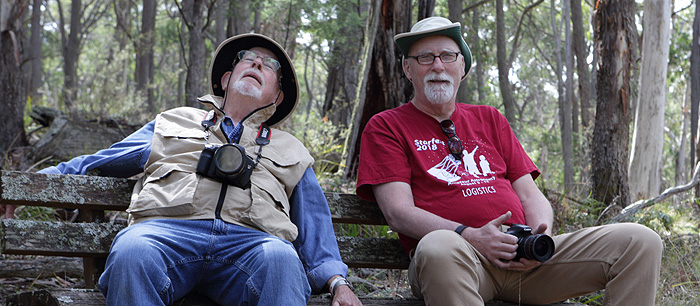 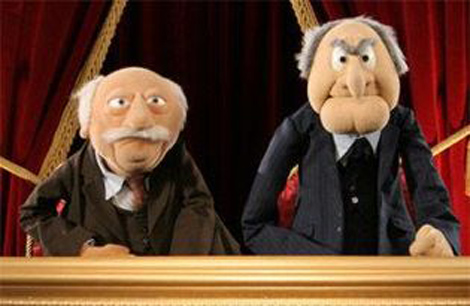 The time had arrived to say goodbye to Allan, Kirsten, and Jordan after a wonderful week in east central Australia. I headed off on the eight-hour car trip with Peter and Kim Read to Bunbartha, Victoria, but only after we got part way down the driveway and Peter realized he had left a toolbox in Allan's garage. The second attempt at leaving was successful. In the Read's trusty and well-traveled Holden Commodore wagon, we started the day-long drive on another beautiful, sunny, warm day in New South Wales. After a few hours of driving, a large radio telescope dish became visible just to the east, a few miles away. As luck would have it, the Parkes radio telescope was very conveniently located along our route that headed southwest, so we stopped briefly and took a few photos on a beautiful, sunny, cloudless, vary warm afternoon. A nice breeze was moving the trees under a beautiful blue sky above, and both can be seen in the HDR image below. We checked out a few of the inside exhibits, I browsed the t-shirts for something worth carrying for another two weeks, and finding none, we got back on the road after a nice walk and stretch. This particular site was made famous in the movie "The Dish", and it received signals from the lunar module television cameras as the astronauts walked on the moon. Mission Control in Houston switched to the Parkes signal several minutes into the landing because the signal from the big dish was much better than other smaller dishes that they could choose from, which is not surprising. If you are a techno-geek like me (an electrical engineer originally) or a HAM, check out this link: Parkes Apollo 11 Those pages are found on the Parkes web site, they are really fascinating to read, there are many of them, just keep clicking "Next" at the bottom to go to the next page. 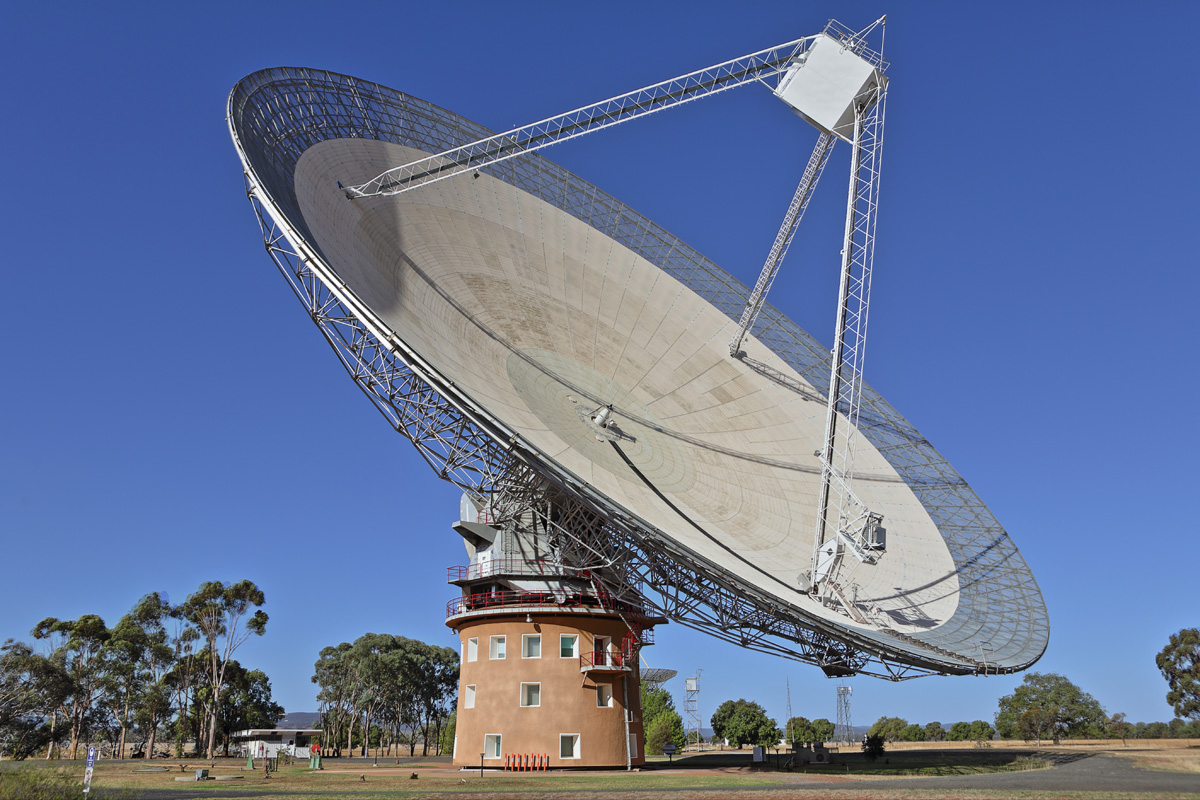 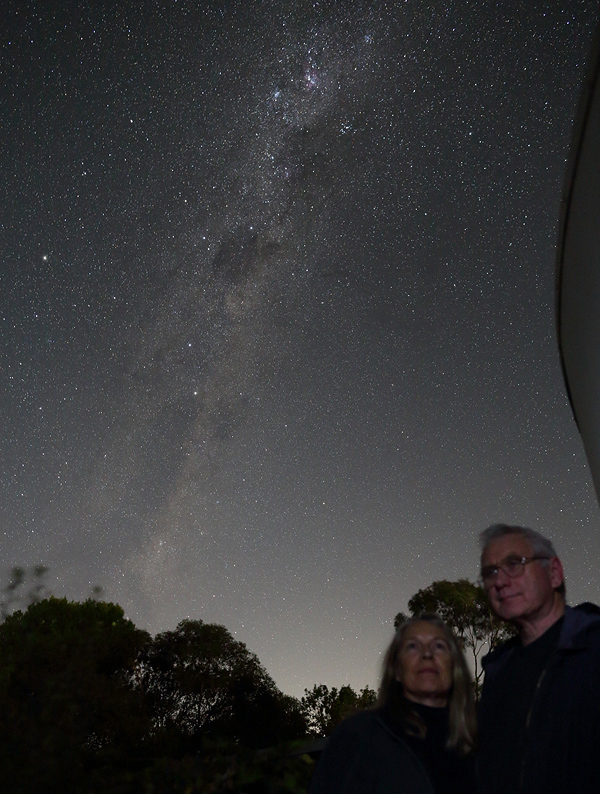 We
had a snack at a McDonalds along the way, and it was interesting to
see what they had on the menu. Of course the coffee choices
were
in Australian terminology, and I don't actually remember what I had to
eat or drink there, but I can say that I have been in an Australian
McDonalds. Eventually the sun got low, and we
experienced the
effect of the sun flashing through the trees that lined the side of the
two-lane road that we mostly had to ourselves on this fine Sunday
evening. The dry countryside was sunlit and beautiful.
Some
of the higher hills were bathed in the sun's golden glow out the window
to our left. We
had a snack at a McDonalds along the way, and it was interesting to
see what they had on the menu. Of course the coffee choices
were
in Australian terminology, and I don't actually remember what I had to
eat or drink there, but I can say that I have been in an Australian
McDonalds. Eventually the sun got low, and we
experienced the
effect of the sun flashing through the trees that lined the side of the
two-lane road that we mostly had to ourselves on this fine Sunday
evening. The dry countryside was sunlit and beautiful.
Some
of the higher hills were bathed in the sun's golden glow out the window
to our left.While many would have been bored, I found it a good way to see a good bit of non-touristed Australia, what one might call the authentic parts outside of the cities and popular locations. This is the kind of travel that I enjoy most, and of course the conversation was interesting. Daylight faded. After dark, we stopped for a beer and dinner in the medium-sized town of Narrandara, NSW. First, we walked around for a bit to stretch our legs and came upon a bar with some good Australian beer. Kim did a little grocery shopping while Peter and I enjoyed a beverage. Beer finished, we headed back up the street to an open restaurant, and I think I had some type of pasta and meat dish. The town was mostly deserted, but there were many open restaurants to choose from on this Sunday evening, and this surprised me a bit. The air was still warm, with a nice breeze blowing. Even though it was fall, to me, summer was in the air, and it felt nice. As we ventured on, I recall looking up at the bright Milky Way from the car as we motored further south still, and I recall thinking about how we had been in mostly a very dark, rural area for six or seven hours. This was truly a very big area with not too much population. However, a drought had hit the area hard in recent years, and farming was difficult. As we got closer to the Read's small town of Bunbartha, we passed by many kangaroos standing on the side of the road. In the US, this is akin to passing deer along the side of a dark road, and it slowed us down a bit and was somewhat disturbing. These animals are very solidly built and can cause a lot of damage if hit by a vehicle, and heaven forbid they come through the windshield. We finally arrived at the Read house, and it was time for a bit of port before I made my acquaintance with the guest room bed. Tired from lots of astronomy and not managing to sleep in sufficiently, I slept a long time, which was very easy since the guest room was in a dark, quiet back corner of the house. I had to look at my watch to figure out what time it was when I woke up, refreshed and eager to start a new day. The light of the new day, now Monday, allowed me to see the garden-covered property that Peter and Kim had planted a couple of decades before, and which now had grown up to surround the house, screen the neighbors, and provide many different areas separated by trees and other plant life. Thankfully, and mercifully, coffee was dispensed liberally from a wonderful little automatic machine that Peter frequented during the day. It became my friend immediately, but I mostly visited it in the morning. Coffee later in the day will keep me up at night, so I only do that when I plan on observing late into the night/morning. Peter gave me a tour of the property and his workshop, and we looked at the secondary holder for a 24" telescope to see how the secondary mirror was fitting. We made a few adjustments and resolved to test the telescope that night. Later on, Kim and I took a walk down to the river, which gave me the overall perspective of the town and its surroundings, and Peter joined us on our way back. I noted that the neighbor's lawn across the road looked like a golf course, so clearly obsession or preoccupation with one's lawn is not confined to the suburban United States! Overall, the streets and homes around their place was a bit like a large subdivision with large lots in the middle of irrigated farm land. Peter and I made a trip to the post office and to a nearby store for some port for evening sipping after the astronomy was done. Kim had prepared dinner in the slow cooker, which was fantastic, and after dark we set about some telescope testing with full stomachs. We did a bit of star testing of the 24" to verify that everything was working properly, and it seemed to be in good shape. We tried to do some artificial star testing, but we could not get the artificial star far enough away to bring the resulting spherical aberration (from a source that is not at infinite distance as a star would be) down to an amount that made testing useful. We could, however, see that there was no significant astigmatism. We went back to star testing, and we could see a nicely corrected, round star image through the telescope. On Tuesday I went for a morning run, and didn't seem to get tired, which is always nice. I found my way back to the house and we made some parts for the mirror cell to finish off the morning. In the afternoon, I helped Kim clean up some parts of the gardens while Peter ran errands. Acorns were dropping like needed rain in certain areas, and we raked them up as best we could and cleaned up some other areas. Then it was time for a shower. For dinner we met another astronomer in Shepparton and picked up fish and chips to take to a local park. After a very filling dinner, the others had coffee and we all sat and discussed telescopes. The evening concluded with a bit more star testing, this time getting some very nice results from actual star testing. Peter remarked that the seeing at his shop was rarely as good as it was, so maybe we brought some good luck back from Coolah. Soon it was time for port sipping, which is a superb way to wind down after a busy day. On Wednesday morning I started helping Peter do a bit of sanding on the 24" telescope after it was completely disassembled - as in all parts and fasteners removed, down to bare wood, ready for finishing. The next steps would be sanding and staining. However, I was distracting him a bit, so later on I helped Kim with more yard work, this time cleaning up a trellis and removing volunteer trees, vines, leaves, and whatever else needed to be hauled away. After a bit of washing up, I was ready for a trip into town, and we went to the bottle shop in Shepparton to stock up on beer tasting supplies and sampled those around dinner time, which was duck and vegetables. 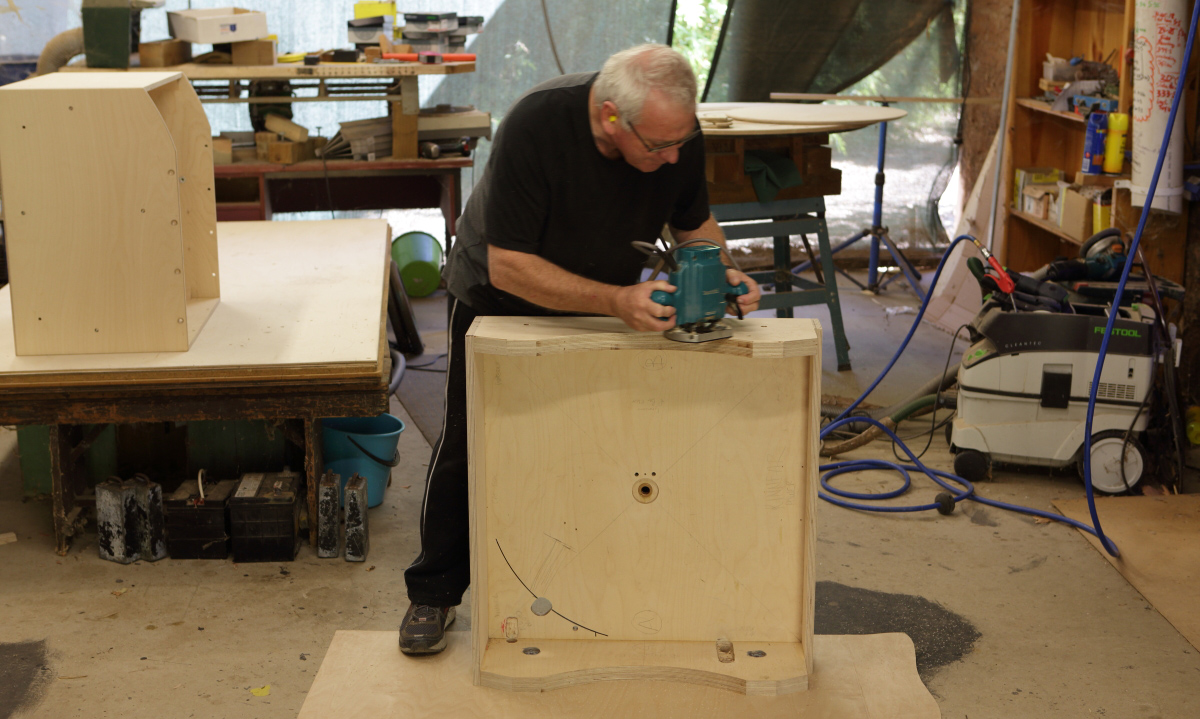 Above Peter puts a chamfer on the side of a rocker box for a 24" telescope. Below we see Peter and Kim at dinner. The fireplace is their source of heat for the mud-brick house, and it was getting very cool in the evenings this time of year, which was well into fall when I was there in April. It was wonderful to enjoy dinner by the fire and learn a bit more about Australia. One interesting fact about their subdivision was that the water source, normally from a nearby reservoir, was switched once per week to bore (well) water. This allowed swimming pools to be "topped up" with water that was better for them. Peter himself did the switchover that night by switching the proper valves. To me, this was just another fascinating tidbit about how people live in different places around the world where water is not as readily available as it is in my midwest home. 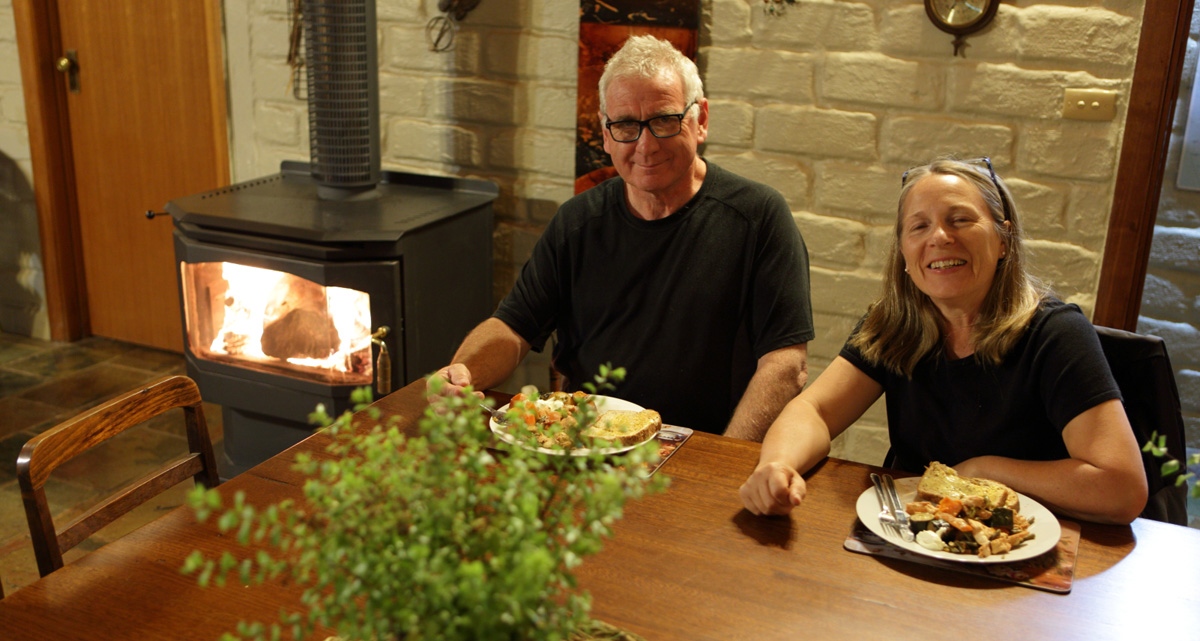 Thursday morning we were up fairly early, and it was time for me to pack up and catch a flight in Melbourne. I crammed everything into my suitcase and filled my backpack to its maximum fullness. I had picked up a few things along the trip, and I didn't really want to leave anything behind except for a few gifts that I had brought along. As it worked out, Peter needed to visit a relative in Melbourne, so they were able to drop me off at the airport on the north side of town on their way to visit them. I thanked them for their wonderful hospitality, and headed into the airport. After a fairly pleasant flight to Auckland, during which I actually managed to nap for a little bit, a miracle for me, I retrieved my bag and had to walk to the domestic terminal in the fading light of evening. It seemed that a large percentage of the Auckland population was there, too, and after noting some delays, I finally found a seat and had a beer while downloading many photos from the past few days and doing a bit of editing until my flight from Auckland to Kerikeri, which was very close to the north end of the North Island, and which is also referred to as the Bay of Islands. They didn't let us into the gate area until just before the flight, and I was quite shocked when I went through exactly zero security on my way to the turboprop aircraft that would make the short flight. I found this slightly disconcerting, but also quite nice. It is wonderful that in some places in the world you can still board an airplane without going through a security check. After a short flight, I arrived in Kerikeri and quickly retrieved my bag. Walking into the terminal, I found that it looked larger from the outside, and inside it was roughly the size of my living room! With little square footage to cover, I quickly found my next host because he recognized me almost immediately. Stephen Hovell is a New Zealand native, and a dedicated, frequent and prolific observer of variable stars. For this task, he utilizes his blue-tinted 28" f/3.3 SDM telescope named Kororia in his hilltop observatory. After a 45-minute drive or so, we arrived at his house, I settled in, and we went up the hill between episodes of clouds to see the observatory and telescope. It was a beautiful instrument, and produced good images despite a partial moon. However, the moon made for good photos of the observatory from the outside. On a long astronomy trip, the moon won't be perfect for all of it! 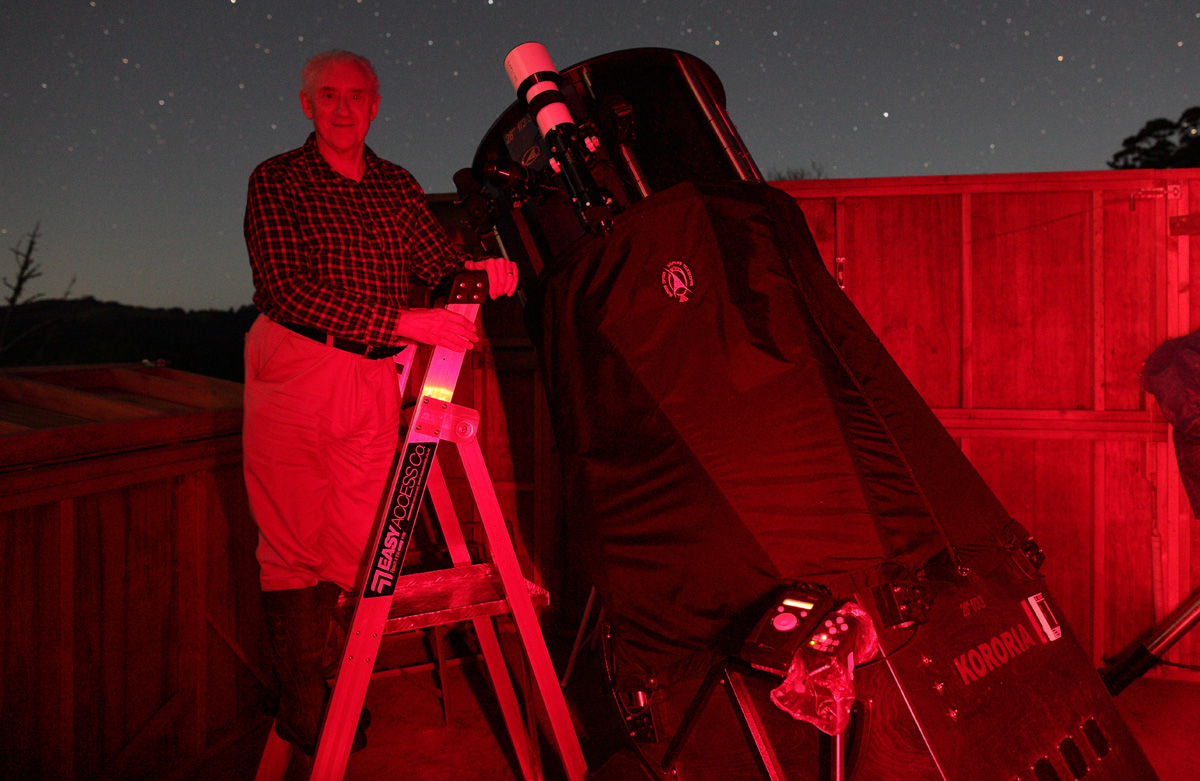 The observatory is located on a hilltop, up a steep climb from the house. Hiking up the hill is enough to get the blood flowing and wake up a slightly drowsy observer, but don't try to carry your coffee up the hill unless you have a lid on it! The hilltop also provides a great view of the surrounding countryside. Below, left, is a photo of the walkway, looking down toward the house. It is much steeper than it appears in the photo, I can tell you for sure, and one must be careful when the grass is wet. At right is Stephen's observatory under the southern Milky Way and the Magellantic clouds, with some clouds approaching. It was not uncommon at all to have the clouds roll in and a brief shower, and then it would clear right off again and we would go back to observing after a beer break. Light pollution was fairly minimal, similar to a typical rural area with some population. 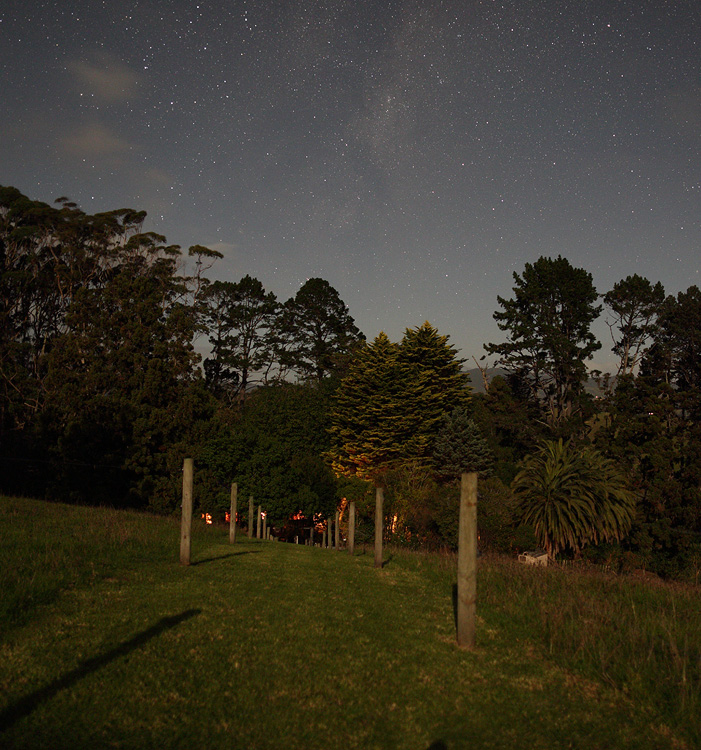 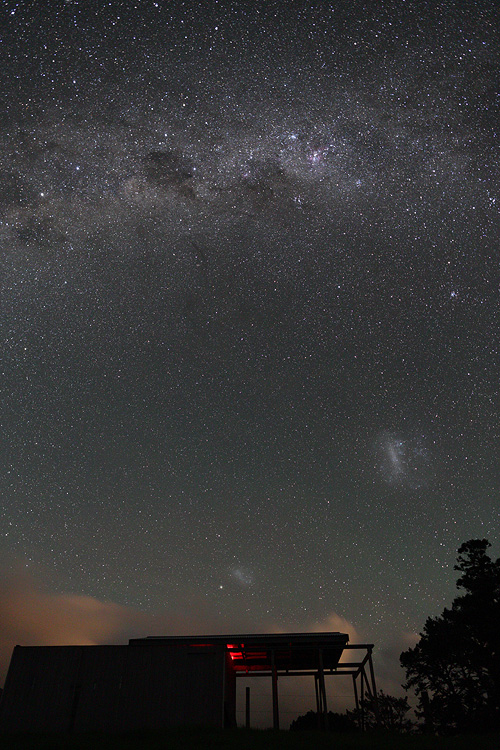 While my photo of Allan and his telescope under the southern sky is my favorite of the trip (see Part 1 here, and scroll to the middle of the article, photo is on the right of some text), I had some time to get creative with my camera, and the photo below is my pick from this leg of the trip. I moved the tripod around until I found a gap in the trees on Stephen's hilltop that framed the southern Milky Way quite nicely. My neck did not enjoy the maneuvering necessary to capture this, and my shoes were quite wet after trudging through tall grass, but it was worth it, and a unique image was my reward for the effort. 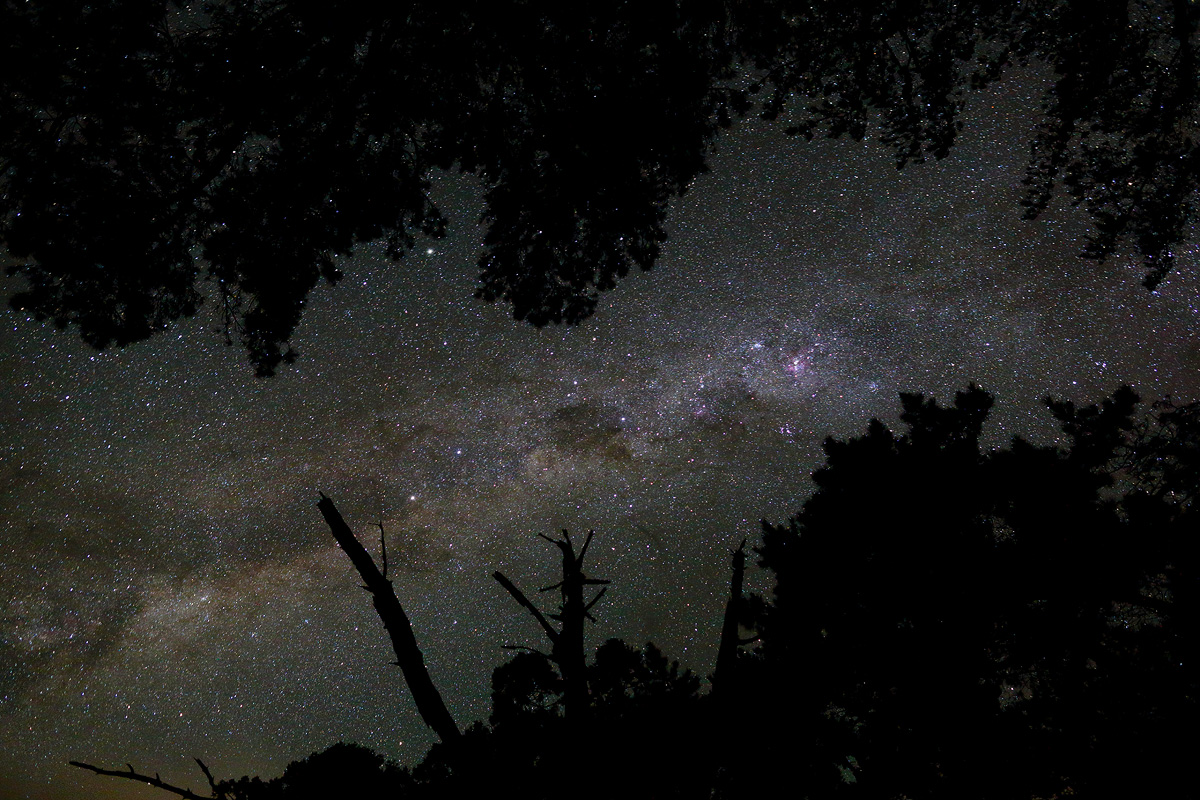 New Zealand is simply a beautiful place, but, at least where I was, the volume of tourists was so much less than I expected. The scenery was staggeringly beautiful and colorful. For some reason, the place just seemed to have the color saturation adjustment turned up a few notches past other locales. When you combine uncrowded with beauty, it's a winner in my book, and, as a bonus, I had an astronomer who was willing to show me around a bit. This proved particularly damaging to the free space on my camera's memory cards! Prepare for an onslaught of beauty. No, I'm not bragging about my photography, I'm promoting the location! This is the point where I have more photos than text in the rest of this article. The photos still stop me in my tracks when I see the months later, and I am grateful for Stephen's excellent tour of his local area. We left his house well outside Kaitaia on Friday morning and headed into town for a nice lunch at a Maori-run restaurant in Awanui. After a huge seafood platter, we headed north to the Cape Reinga area, stopping first at the giant sand dunes that are just south of the cape. Imagine having this (below) just over an hour's drive away - Cape Reinga, the northwest tip of the north island of New Zealand. The Tasman Sea is on the left, the Pacific on the right. It was late afternoon when we arrived at the lighthouse, and the sun was getting lower in the west, as you can see from the shadows. 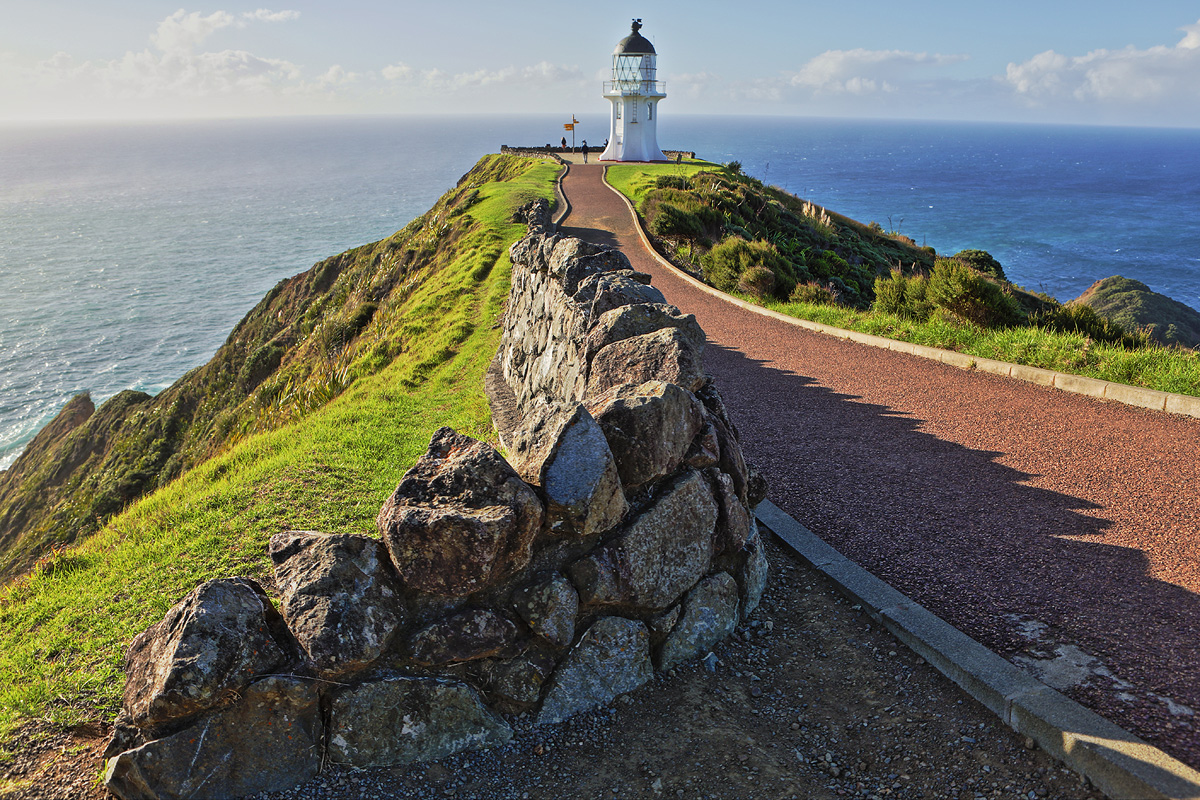 To get to the view above, however, I took a detour from the paved path and took a short, steep side trip up a hill to capture the view that one would see if one turned around and went back up the hill. That lonely beach, called Te Werahi, was a bit of hike, and the sun was starting to get low, so we didn't make that hike down the hill. I preferred the view from above in this case, and would get my toes wet at other beaches. However, the view was still magnificent. 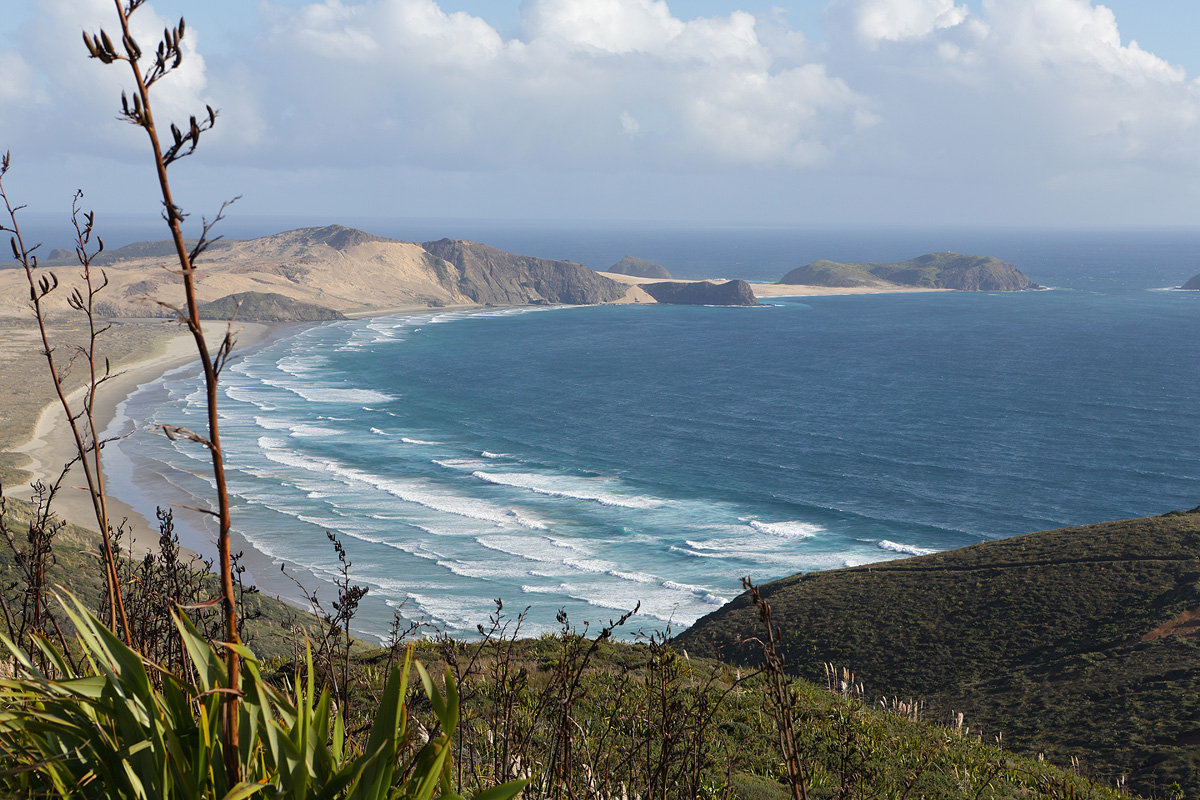 The "road signs" by the lighthouse gave distances to various interesting locations. The path that we walked down to the lighthouse is partially seen behind it. 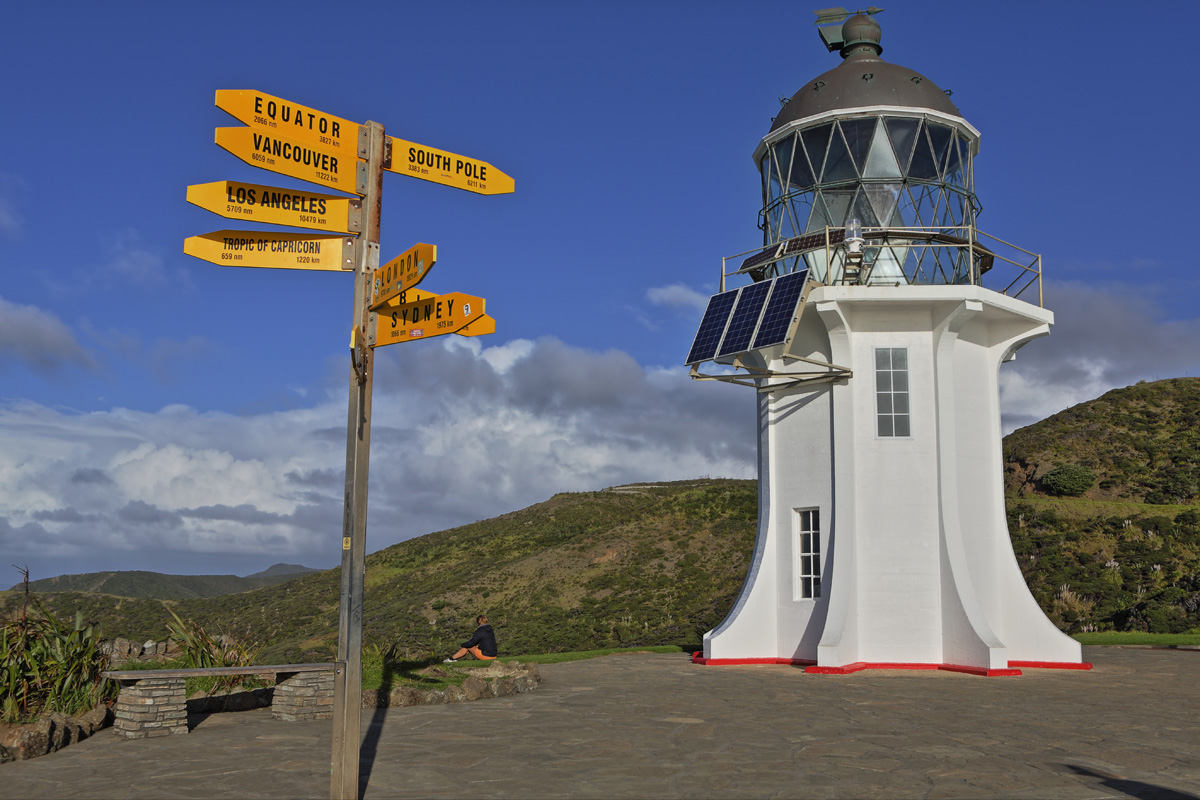 Instead of the aforementioned other hike down to the beach, we drove to a different spot for some more HDR photography as the light faded. Of the whole trip, these photos surprised me the most with how they turned out after combining three images. The bay is called Tapotupotu. The beach itself was smooth sand and almost free of footprints, and only gentle waves rolled in. It was so very quiet, even with a campground situated just up the small river from the beach. It was here that I started to slow down my brain after the whirlwind of the last couple of days. Deep breaths were inhaled as I walked along and felt the gentle breeze. It was a serene, beautiful spot, and I was grateful to see it. 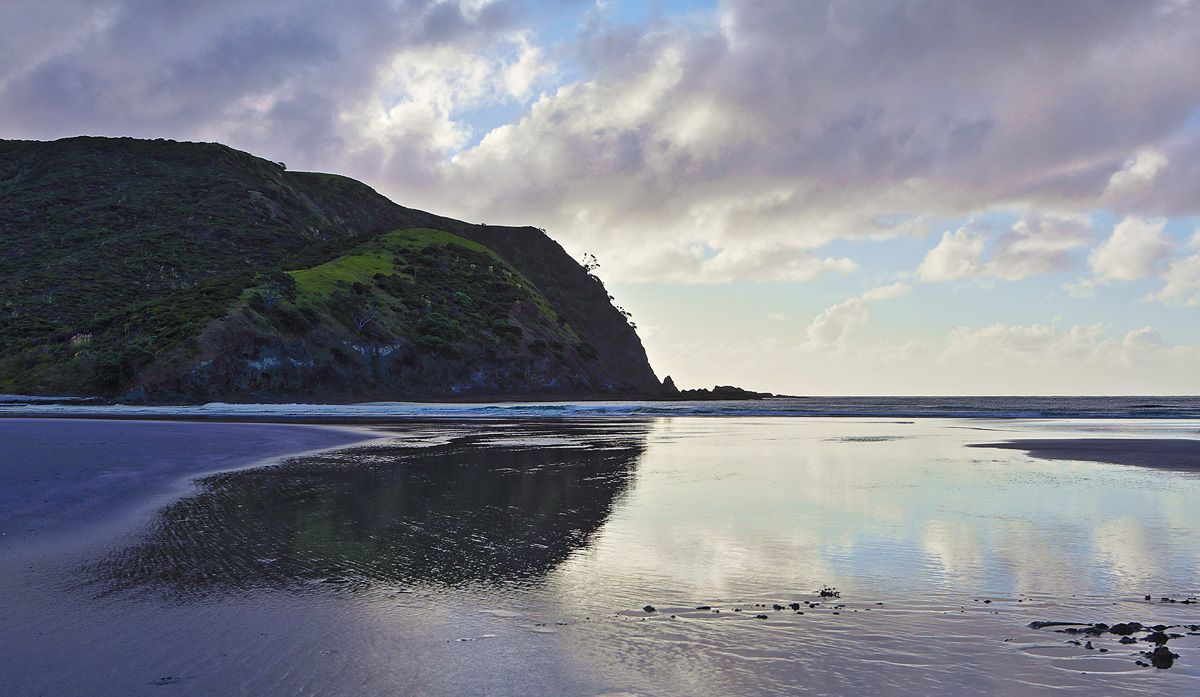 Tranquility achieved, and with the sun setting, we went back to the car and headed south, stopping along the way to shoot a few photos here and there. We got back to Stephen's around sunset, and did some more observing and I did more photography. Some of those photos from this night have already been shown above. I downloaded photos and began processing some of them as Stephen kept checking the sky to get some observing in during times when the clouds were absent. Saturday dawned sunny, and we watched a bit of the Masters golf tournament in the morning. This was different because I would normally watch it in the afternoon, but it worked out well since I could catch up on the tournament and then we could go out for some more sightseeing. Heading out again in the late morning, we stopped at the Gecko Cafe in Kaitaia for lunch, and again I found very good food. Then it was off to three local beaches for some relaxing and hiking. The first was Tokerau Beach, seen below. I went for a nice walk there and just enjoyed the breeze. Again, the weather was ideal - the day featured bright sunshine and very pleasant temperatures, with a nice breeze. 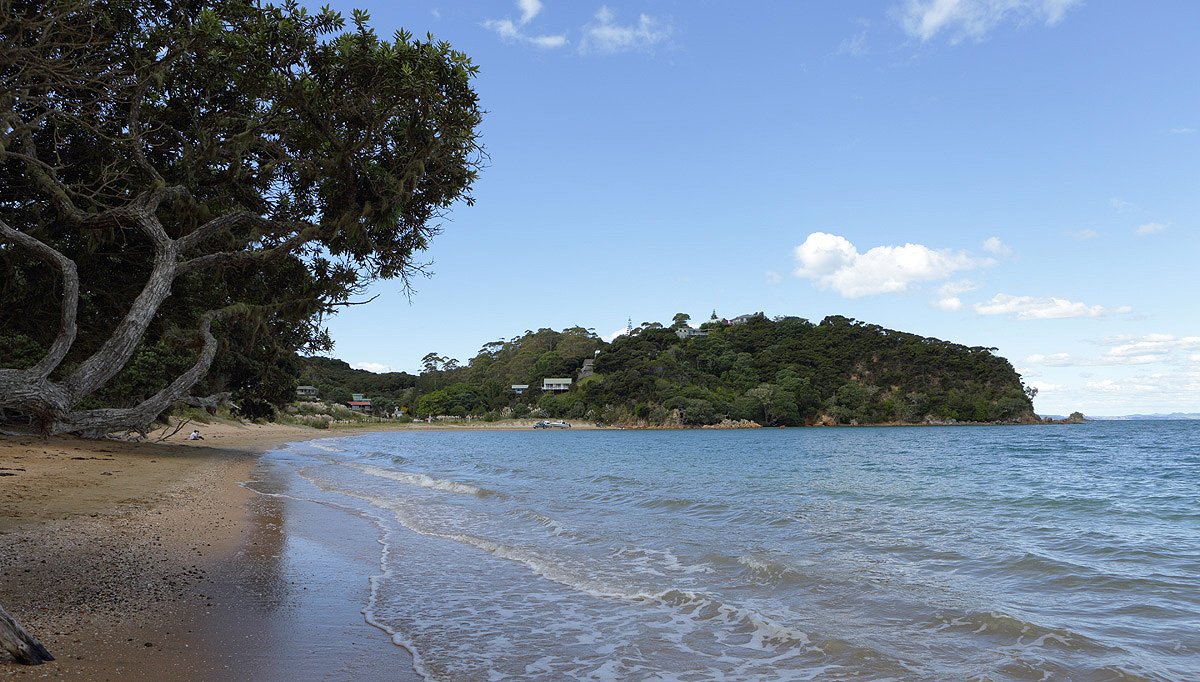 After a short drive, we arrived at our next beach. The first image below is of Matai Bay, and Waikato Bay was visible right behind me as I took the photo from the small peninsula between them, which was accessed by a short hike from the parking lot. The view was postcard-quality. 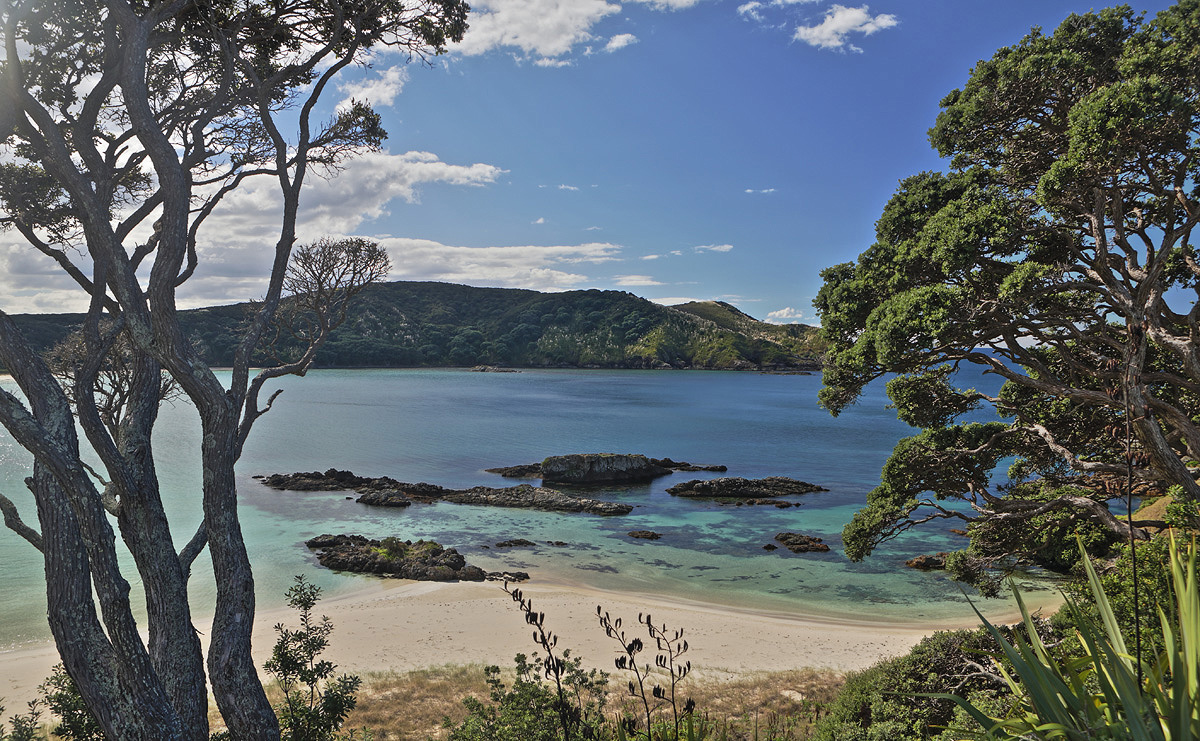 Stephen decided to join me after a short time, and we scrambled down to the beach and followed it back to the car after enjoying the beautiful weather and relatively calm winds. With fall arriving, it was not too hot, and as far as I was concerned, it was just about perfect. Below is the view from the parking lot with the moon rising in the northeast - not bad - not bad at all. In Hawaii, a place like this would be mobbed with locals and tourists, but here there were only a handful of people on probably a mile of beach. It would be easy to sit here for most of a day, and then enjoy the stars after dark, but we were off to our next destination on Stephen's very nice tour. 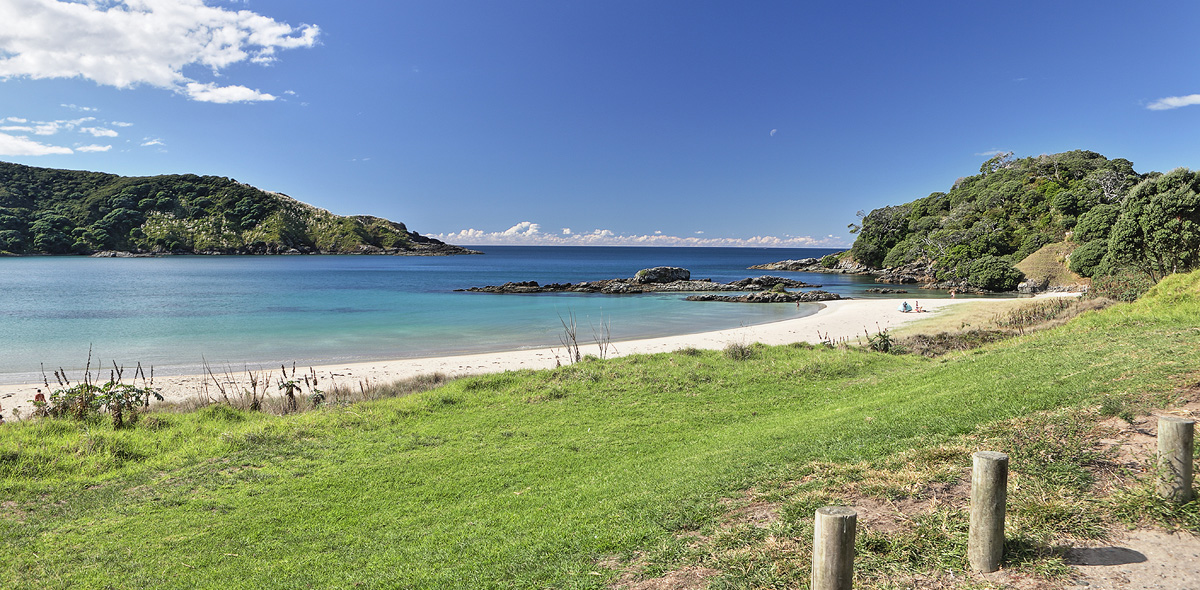 After a short drive south to leave the Karikari peninsula, we next we visited a hilltop overlook, listed on a map as Rangikapiti Pa, and took in the view of the town of Mangonui. From here we could see our dinner destination - the Mangonui Fish Shop. It is just visible in the image below - it is the building on pilings that is closer than the building out in the water with the bridge leading to it, which is where the fishing boats unload. 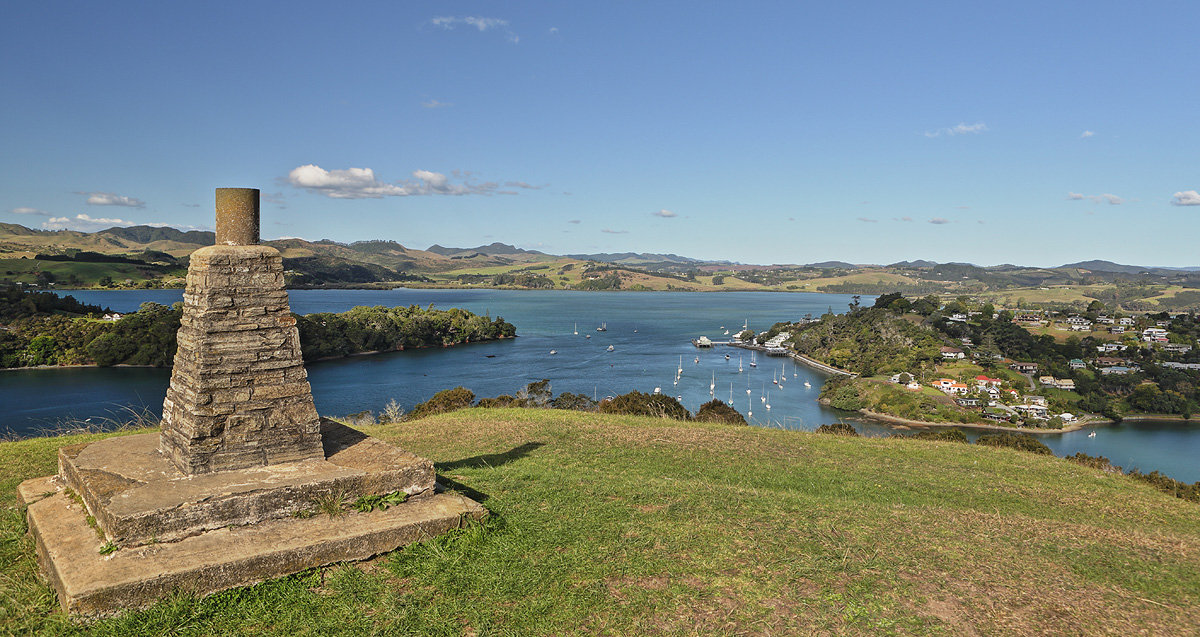 We sat in the restaurant looking out on the inlet, watching stingrays swim underneath the building, as we sipped a beer and waited for our food, and I believe I had more fish and chips. We had just beat the rush and found a somewhat shady small table to enjoy our meal. We enjoyed the food and view for a while and then decided to give up the table to other diners. On the return trip, we stopped at a bottle shop and I found some Australian Hunter Valley shiraz in a small tribute to Allan, as well as an interesting beer or two including and oak-aged stout. During the evening we watched a bit of TV and did some observing. Under the light of a now half-moon, I helped Stephen collimate his telescope and showed him how to accomplish that using a star. The moon would be full for the next leg of my trip. After another good night's sleep and a bit more early-morning Masters viewing, we left for Auckland around 10am. Stephen would be visiting family there, and I would spend a night in a nicely-located hotel in downtown Auckland. We stopped for a short hike down to a waterfall, and then had a very nice lunch in Whangarei, sitting outside not too far from a harbor and watching people pass by as we had seafood and coffee. We then made the final push to Auckland, stopping for ice cream along the way at Stephen's suggestion. I said goodbye to Stephen and thanked him for his hospitality, and checked into the President Hotel in Auckland. After catching up on some email, I went in search of beer and food, and found beer first. I visited the Brewer's Coop and picked up a good bottle of beer at another location. Leaving that at the hotel, I went out for some Thai food and brought it back to enjoy with the beer. After a long day I slept well. In the morning I walked around the Central Business District (CBD) and located some good sushi for lunch, before catching the airport shuttle. At the airport I found that my Qantas flight had been delayed, and if I didn't change flights, then I would miss the connecting flight to Honolulu. After a huge wait, I finally was transferred to a flight to Brisbane on Air New Zealand, followed by a Hawaiian Airlines red-eye to Honolulu, basically the same flights but connecting through Brisbane instead. The flight to Brisbane was fine, but the seat on the red-eye was fantastically uncomfortable, and I only got a little bit of sleep. I arrived in time to get in the long security line for my short hop from Oahu to Maui, where I picked up the rental car and made my way to my friend Stan's house. Stan is basically a mentor to me, and I had last seen him ten years prior on my last trip there in 2009. It was he who had arranged the tour of many of the observatories on the Haleakala summit back then, and of the Faulkes telescope that I mentioned in part 1. It was good to see Stan in person again, and we headed out for dinner at Polli's in Makawao. If there is one thing that Stan enjoys, it is food! After a lot of catching up, I was quite tired, and I headed off to another friend's place in the Kula area where I was staying. After a beverage I was quite tired and slept quite soundly despite the time difference due to my lack of sleep from the red-eye. Tuesday dawned cool part way up the mountain, and I woke up fairly early. Stan's back was hurting and he needed to take it easy, so I headed off to the Iao Valley to get some hiking in and to shoot some photos (see below). I had not managed to visit on my previous trip in 2009. While it started out dry, the rains came, and I headed back down out of the jungle/forest before it got too heavy. I had gotten a bit of workout, I had many photos to show for it, and I really needed a shower. I headed back to where I was staying and just decided to relax for the rest of the day because I was in need of a mental break after nearly three weeks of travel already behind me. I went to bed early in preparation for the next bit of travel. 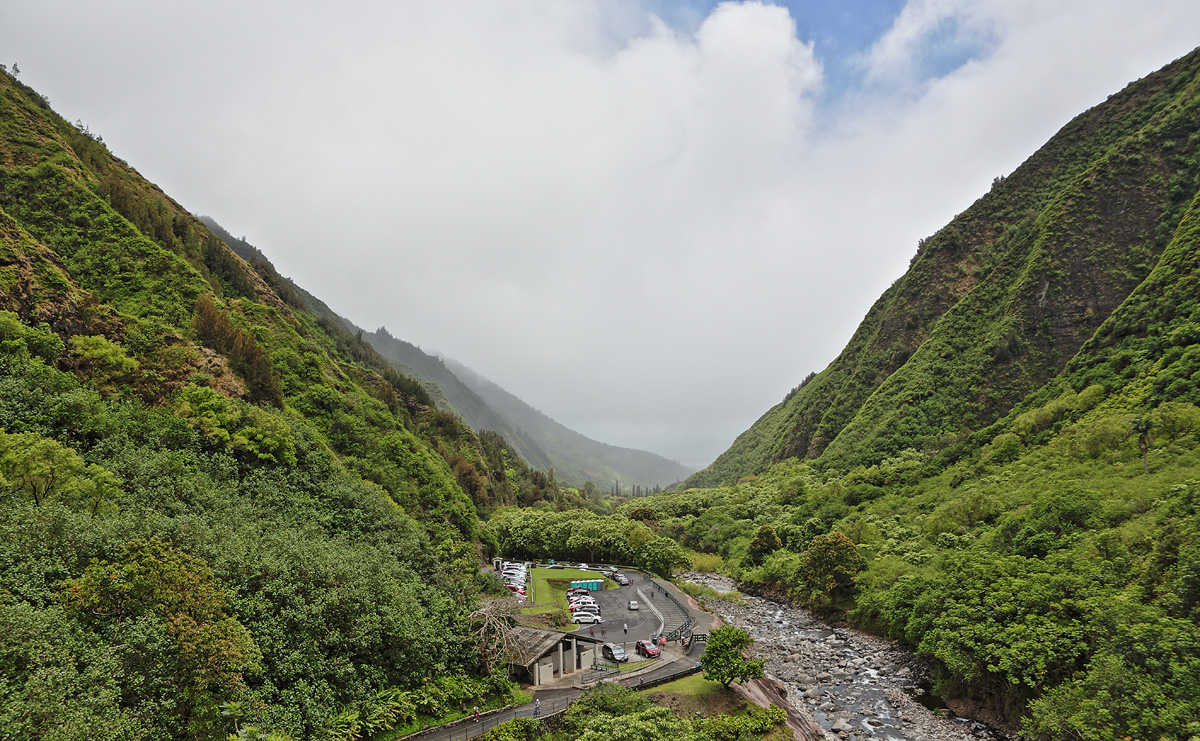 Wednesday morning I got up early, returned the rental car, and caught the shuttle to the Kahului airport. My destination was the big island of Hawaii, and I was visiting a Japanese client named Hirofumi who lived in Hilo and worked on the Subaru Telescope, an 8.2-meter instrument owned and run by the Japanese. Years before he had offered to give me a tour of the facility if I could get to the big island, and now I was taking him up on his generous offer. Giving tours is part of his job, though, so it was another day at work for him. Arriving at the Hilo airport, I met Hirofumi and we headed into town to procure some food for lunch and dinner. We picked up poke for lunch and some bento for dinner, and we headed westward and upward along the wonderful new saddle road that connected Hilo to the west side of the island. We stopped at a couple of places to take a photo or two, and he pointed out the road to where he sometimes observed on Mauna Loa. Soon we made the right turn onto the road that led up Mauna Kea, and we stopped just past the visitor's center at a building with offices used by the employees of various telescopes on the summit. We had lunch there and acclimated a bit to the altitude for an hour. The food was great, I really enjoyed it as we looked at the great views out the windows down the mountain. 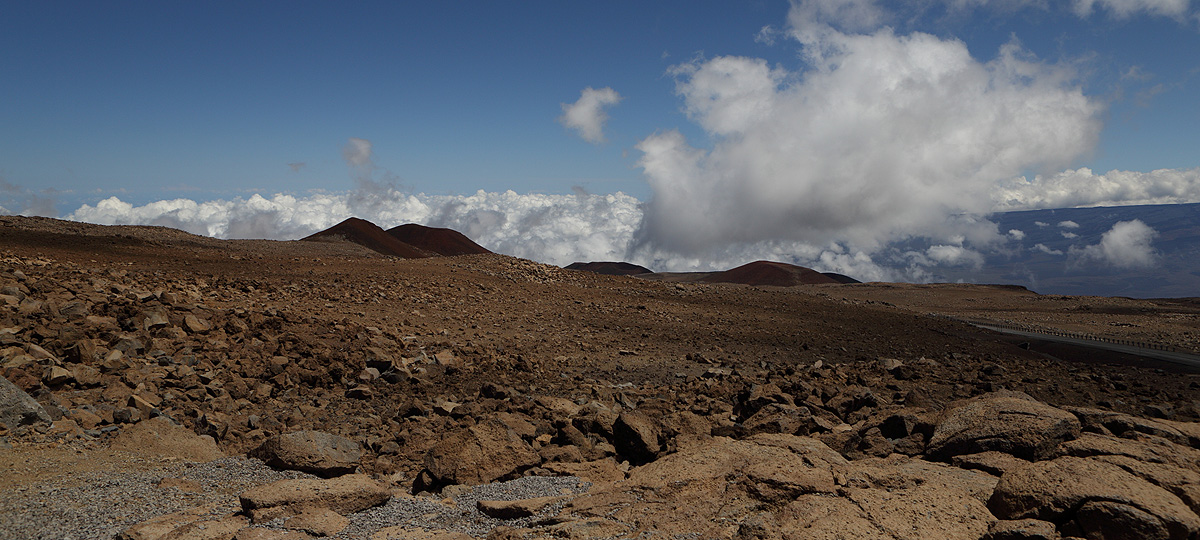 Next it was time to take the famous drive up the very bumpy, steep gravel road to the summit. The landscape, as seen in the photo above, already fairly barren at the ~8,000 foot Visitor's Center area, became completely barren and covered in volcanic rocks of many colors, most memorable was a particular deep red color. With a few brief pauses for photos, we next found ourselves in one of those revered places that many astronomers hope to see someday - the parking lot of the Keck Telescopes. I moved slowly due to the ~14,000 foot elevation, and it took a moment to get my brain to work and get my camera set properly for some photos. I was patient with myself, and basically felt like I had consumed about two strong beers. With a very small amount of snow remaining from a recent snowfall, certain photo opportunities were impossible to resist, as you see me just below with a handful of snow. 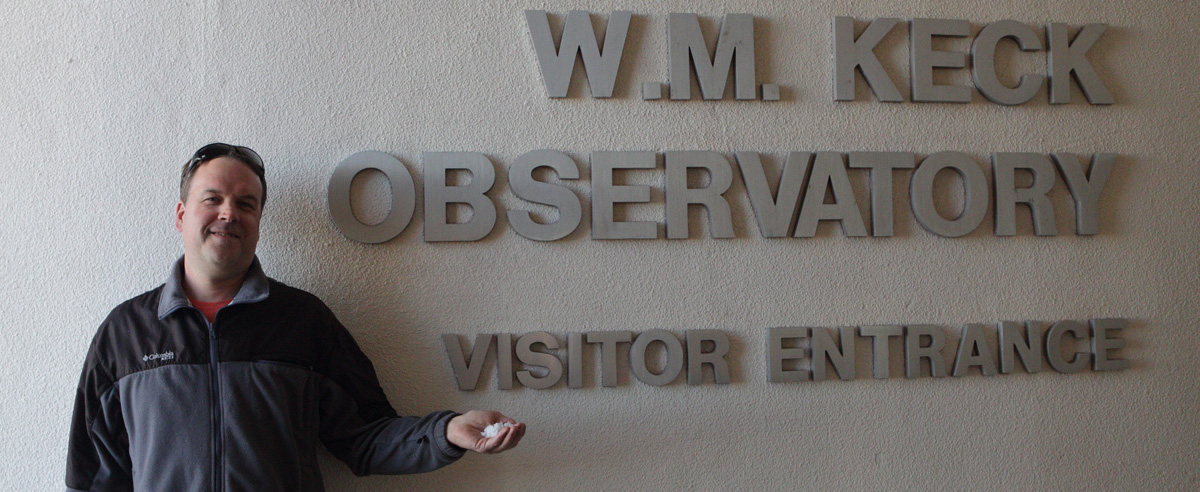 I was surprised to see that there was a sort of visitor's center at the Keck facility. The public is allowed into a small area between the domes, and also into a viewing romm that has glass all around. It is situated at the base of the exterior of one dome, and allows interested people to view one of the Keck Telescopes. Now this was something impressive, and my oxygen-deprived brain slowly ordered my fingers to get the camera ISO set properly so that I could get a sharply-focused image of one of the great science instruments in the world. I also took some time to just look around and try to figure out what was going on. What you see below is the view looking up at the back of the the mirror assembly, with a rear cover (probably an infrared shield of some sort), and then all of the optical actuators above that. The rears of the hexagonal mirror segments are visible, and are shadowed/shaded. The telescope is pointed nearly horizontal. 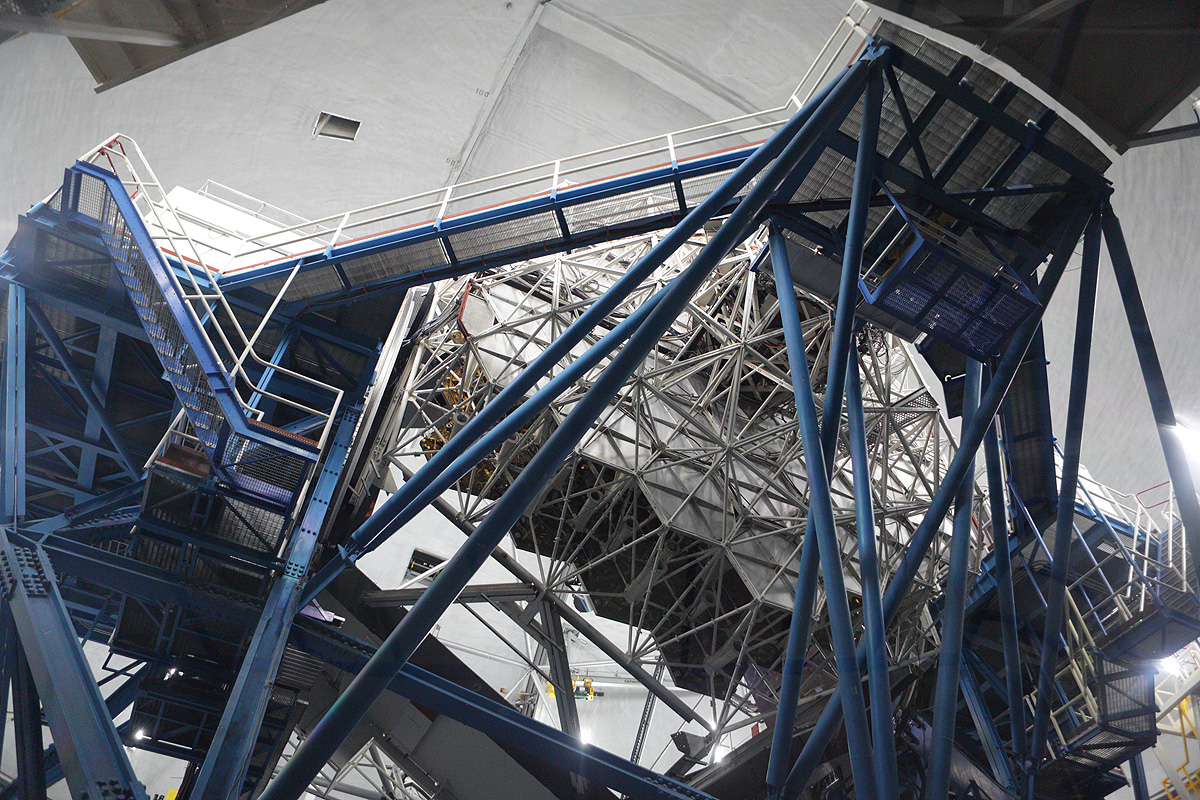 Next we drove to the Subaru Telescope, just a short distance away and sharing the ridge with the Kecks. It was a very short drive. 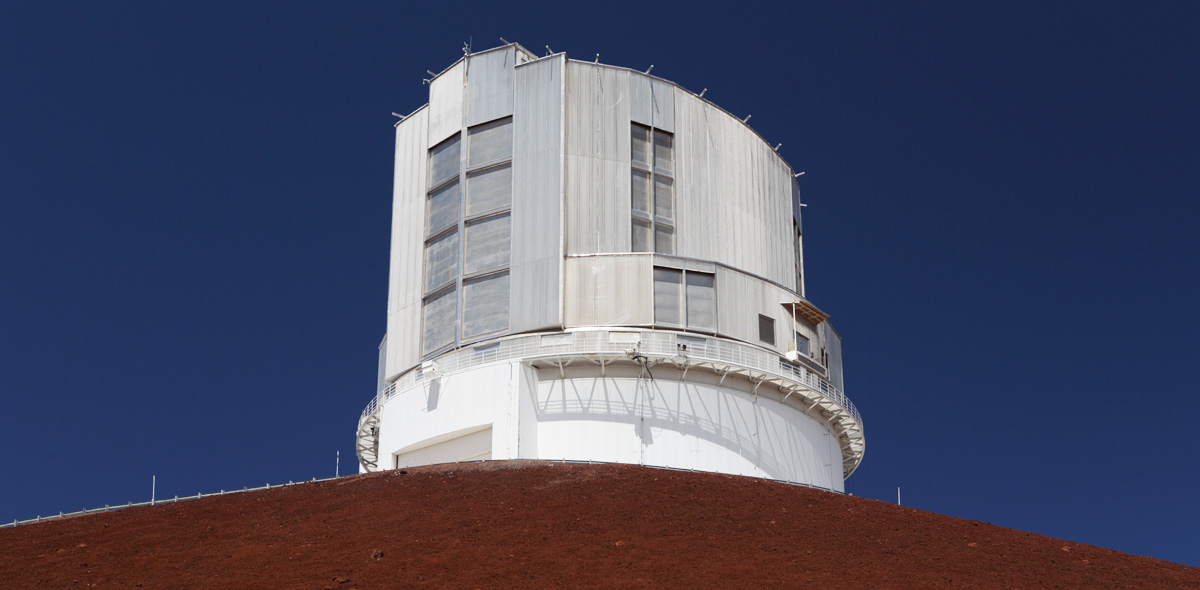 This is the enclosure of the 8-meter Subaru, a photo taken from the road as we drove up to it. The deep blue of the sky, the dark red of the ground, and the white and silver of the dome are quite striking in the bright sunlight at nearly 14,000 feet elevation. Americans do enjoy the combination of those three colors. The official observatory web site is here: Subaru Telescope Web Site We began the tour inside with the office area, and then we took the elevator up to the telescope level. Many photos were taken attempting to show the scale of the massive instrument. The photo below at left shows the lower baffle assembly and structure quite nicely. The telescope can be used in either a standard Cassegrain arrangement, with instruments behind the primary mirror. It can also be used in a Nasmyth arrangement - there are two flat mirrors stored in the center baffle that can be positioned to send the light either to the right or left, just above the surface of the primary, through the axis of altitude rotation, and to instrument groups in separate rooms that are on each side. One flat mirror has a silver coating for infrared use, and the other is aluminized for work in the visual/optical range. As I recall, as seen from the perspective of the photos below, the light goes to the right side to visual-wavelength instruments, and to the left for infrared instruments. The photo below at right shows my tour guide and myself, the Cassegrain secondary reflecting near the top of the image, and some instrument package directly behind us at the Cassegrain focus. 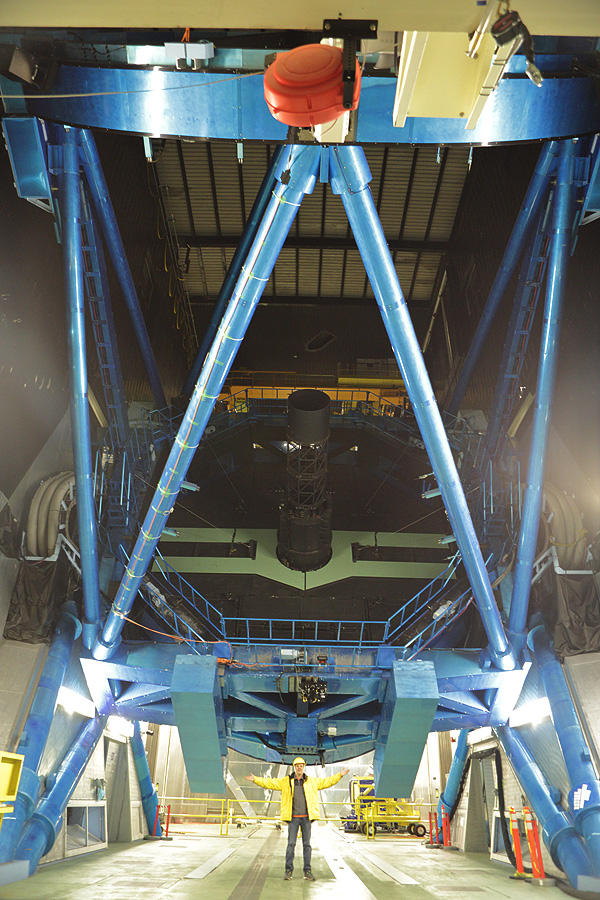 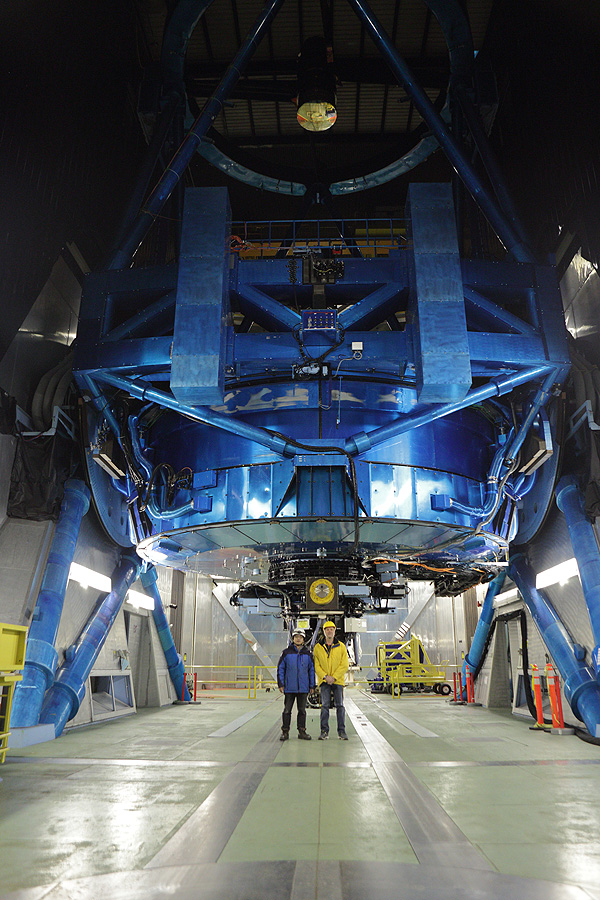 The primary (covered while we were there) is f/1.8, and is 7.9 inches thick, made from a very low expansion material. It is supported by 261 computer-controlled actuators to maintain its shape, and there is a hole bored in the back of the blank for each actuator connection. For the Cassegrain focus, the telescope utilizes a secondary mirror that makes for an f/12.2 system. For the two Nasmyth foci, as I described above, the optical (visual range) operates at f/12.6 and the infrared at f/13.6, using different secondary mirrors. We saw the storage areas for the other Cassegrain secondaries, stored in their holders facing straight down. These are interchanged for different observations. I was allowed to lie on the floor near, but of course not under them, and shoot a few photos. Next we took a walk around the outside of the dome on the catwalk, just as I had done about a week and a half before on the 3.9-meter Anglo-Australian Telescope at Siding Spring (see Part 1 of this trip article). I photographed the neighboring Keck domes and some of the domes on the other ridge of the summit east of where we were. We would go to the other ridge later for sunset photos over the Kecks and Subaru. 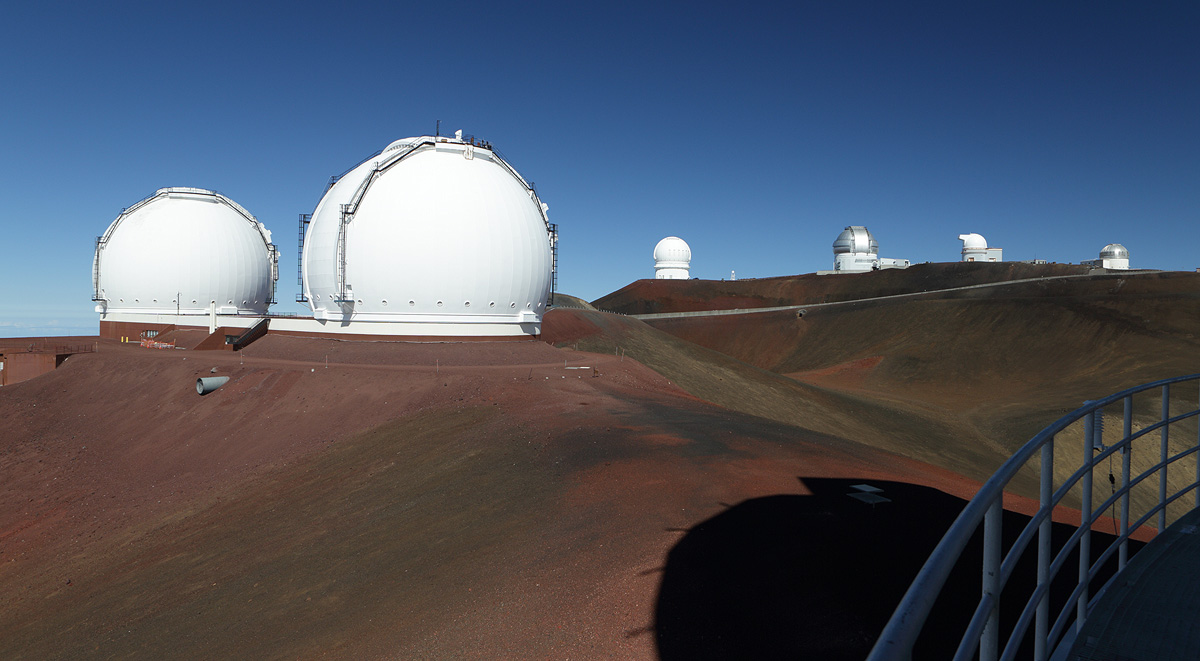 At this point I was adjusting a bit to the altitude, and I took the opportunity to text a few people from the Subaru catwalk. It took a few tries, but eventually it worked. Back inside, we went up quite a ways for some views of the telescope from a higher perspective. This showed the full 8-meter telescope a bit better. This turned out well, so I'm providing a huge image of the telescope here to show the detail. The shutter/doors are on the far side of the building. Enjoy scrolling! 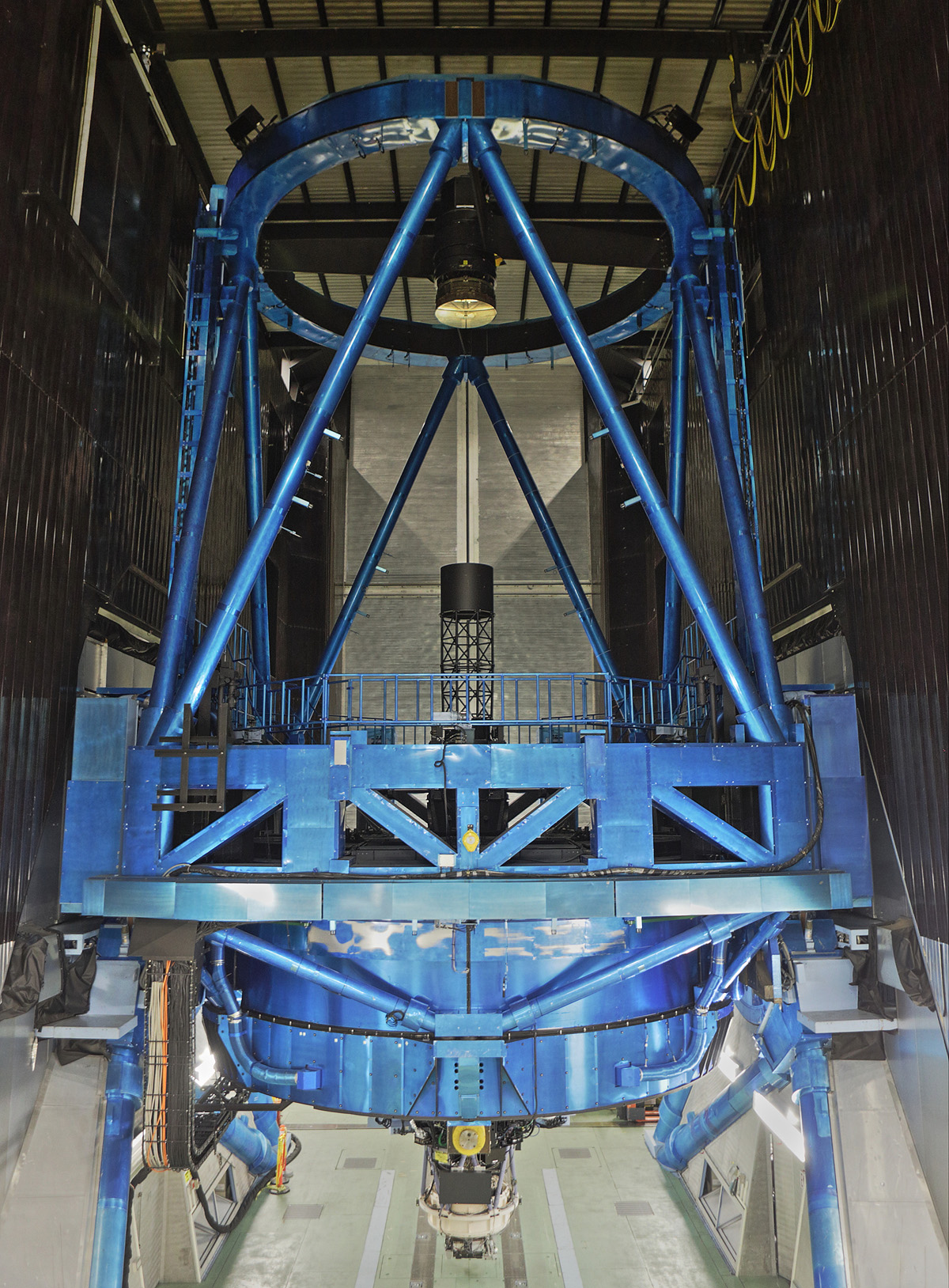 Next was a tour of the huge, round ground level storage and work area where various fixtures and equipment was stored, including a huge lifting fixture for the primary mirror, the massive coating chamber that is used to recoat it, a small machine shop, and a large amount of other various equipment. The support for the telescope occupies the center of this massive space, but it is still massive even with that occupied. After seeing the control room area, complete with massage chair, it was time to head back down the mountain to see if the Visitor's Center was open. It was not, but we spent a bit of time at the lower altitude to save our strength and get a bit more oxygen. As sunset approached, we headed back up to shoot some photos. The temperature had dropped significantly, and a very cold wind was blowing. My hands were just about numbed by the icy gale as I set up my tripod. First we shot photos of the domes, then of the shadow of the mountain extending off to the east down toward Hilo, which was visible through the clouds. The moon was rising opposite the setting sun, making for a superb photo opportunity. 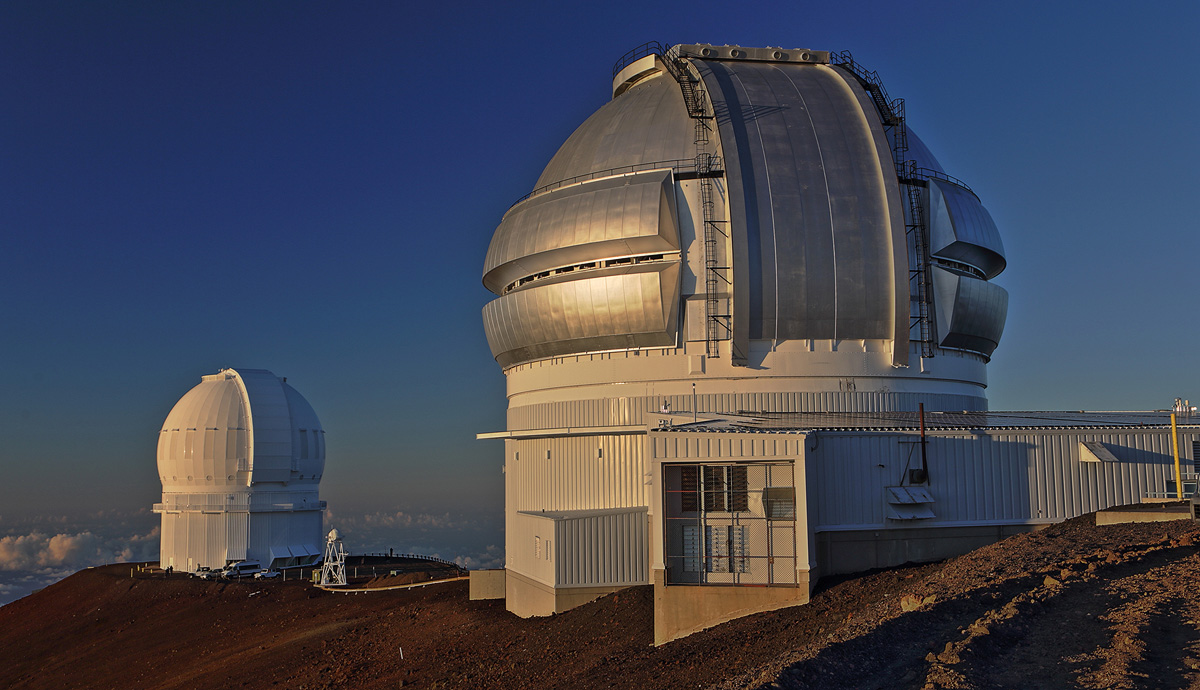 Above, the closer dome is 8.1-meter Gemini North facility, and behind it is the 3.6-meter Canada-France Hawaii telescope. The Gemini's ventilation system activated as we where there, and the vent slits on the dome opened to bring in cooler air, as seen in the photo. Swinging the camera to the right and walking across the road, the scene below was recorded with three exposures that resulted in the HDR image below. Note the Hilo harbor and break water in roughly the center of the pyramidal shadow of the mountain. The view was marvelous, but frigid. 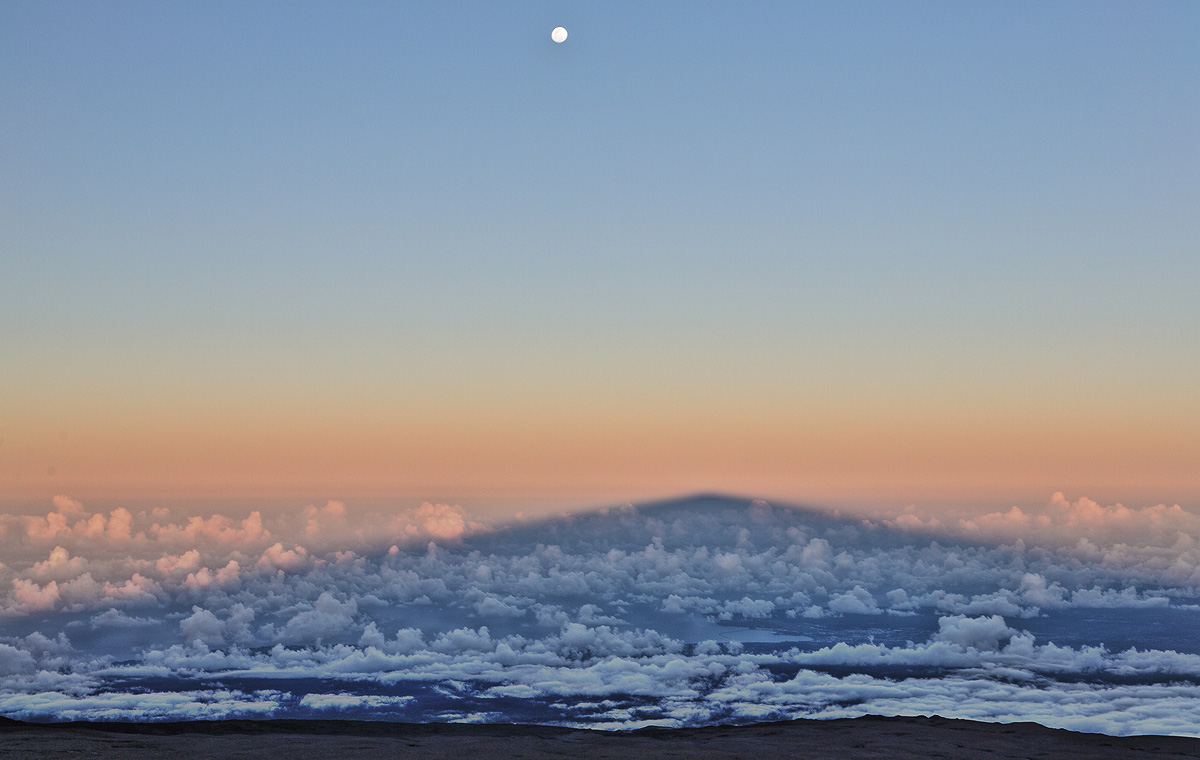 Next we moved to the west side of the ridge to shoot sunset photos. While we were dressed in reasonable winter gear and hats and gloves, we noted many tourists huddled in the wind shadow of the dome right behind us (the University of Hawaii 2.2m telescope) trying to keep warm in inadequate clothing and even shorts! We laughed silently at their stupidity, but at least they made it all the way up there for sunset. Below is my favorite HDR image, Subaru at left just opening its shutter, Kecks at right. It was really cold and the moon was full, so we headed to a lower altitude to have our bento dinner and to set up my friend's telescope for a bit of testing. 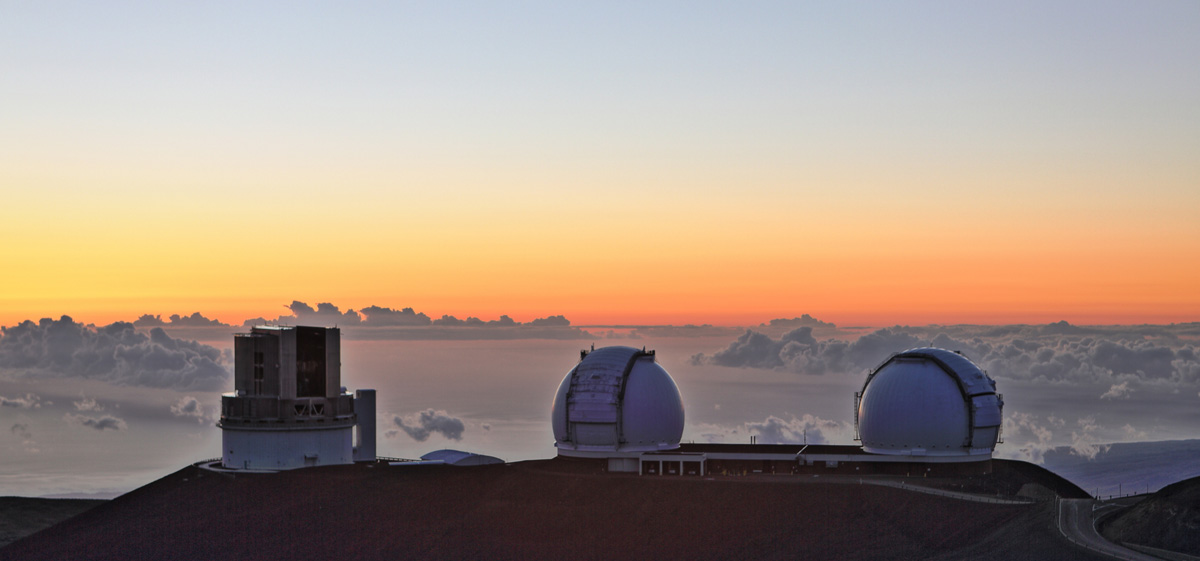 We settled on a small parking lot down the mountain a bit, but it was still cold and quite windy. An astronomy tour group was already set up there, and tourists in borrowed yellow parkas milled around the van that had brought them up for their viewing through an SCT and other instruments. They left after an hour or so, and the parking lot was ours. An occasional car headed down the mountain, and otherwise the only noise was from the rather stiff and gusty wind. The moonlight provided nice illumination of the landscape and telescope as we did a little bit of observing and then eventually decided to pack up and head down to warmer weather. Below, Orion is seen above the telescope. 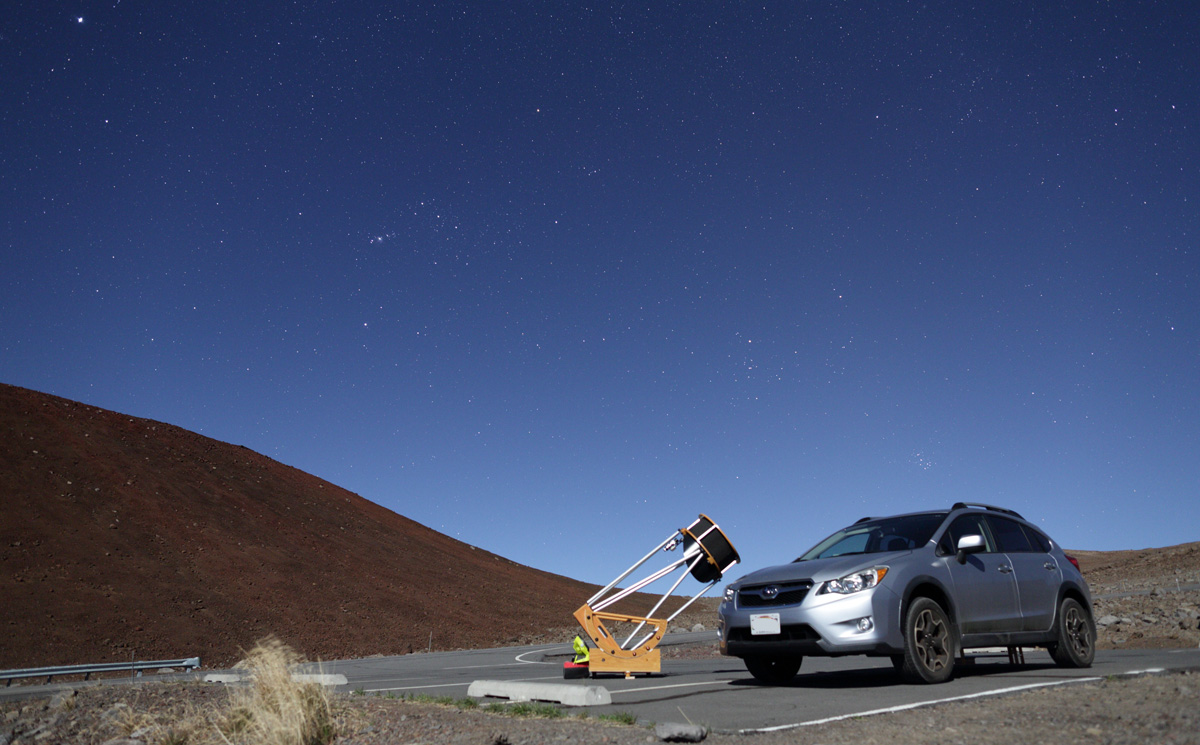 Finally, as a tribute to the southern sky, I managed to get a quick photo of the Southern Cross and Eta Carina with the camera resting on one of the concrete parking lot barriers. Crux is roughly in the center, and Eta Carina is faintly visible just above and right of it. This was to be my last view of it on my trip, and it is now just a shadow of its Australian glory. 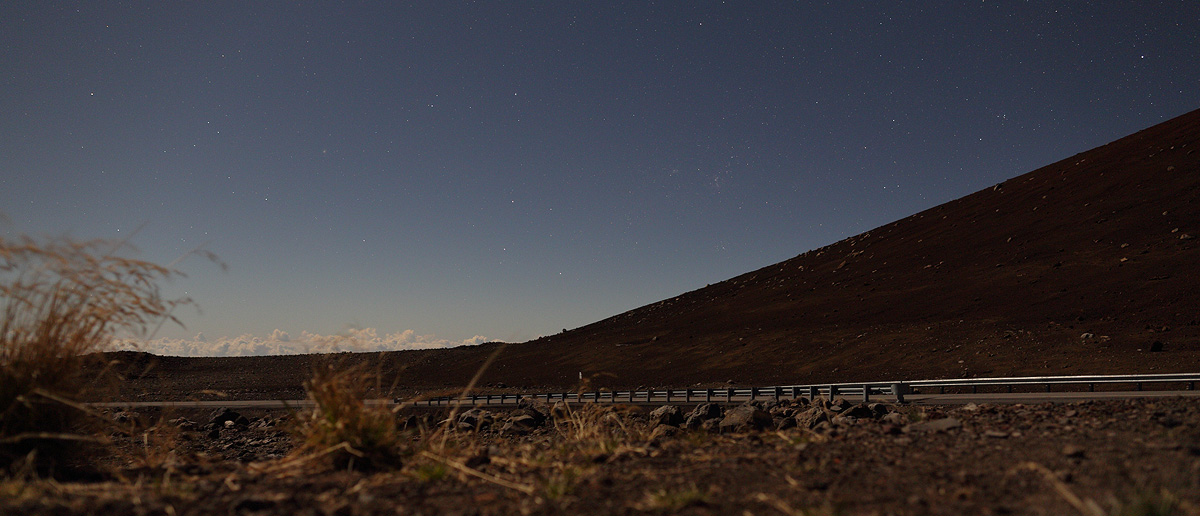 I was very tired, and it was good to head down the mountain to warmer weather. I picked up a 6-pack of local beer on the way back into Hilo, and my friend dropped me off at the Hilo Seaside Hotel after I thanked him for a wonderful day. I sat in the warm courtyard garden, where it was roughly 80 degrees, and sipped a cold beer as I thought about how just a few hours before my fingers had just about been numb from the cold summit wind. What an island. The hotel was very nice, and after a long but stimulating day, I slept well. In the morning I had breakfast at the hotel and then walked over to a nearby park to see the harbor a bit. The photo below at left is from Coconut Island. Next, I ventured to the west side of the island with another client named Dom. Below, right is an image after we had a beverage and watched the sunset over the Pacific. It was a much warmer moonrise than the previous night's! 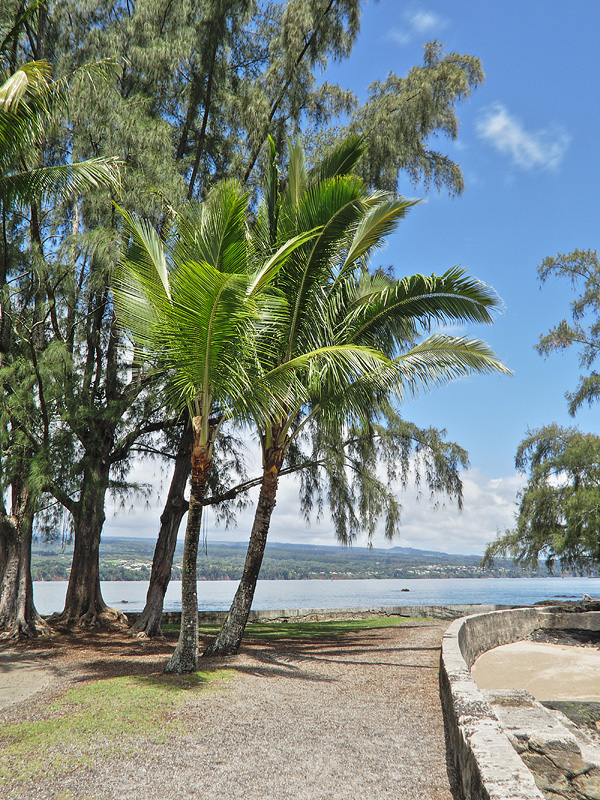 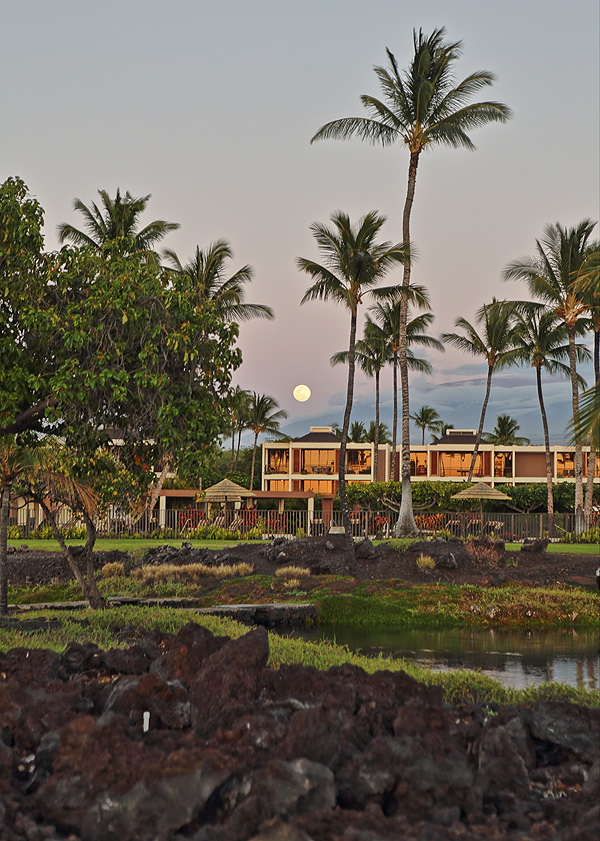 In Waimea we also visited the headquarters of the Keck Telescopes and looked at the displays in the lobby that were set up for tourists and other interested parties. Those displays are in the lobby, as seen below. We went inside, but I liked the photo better from the outside. Note the glass doors with etchings representing the segmented mirrors. 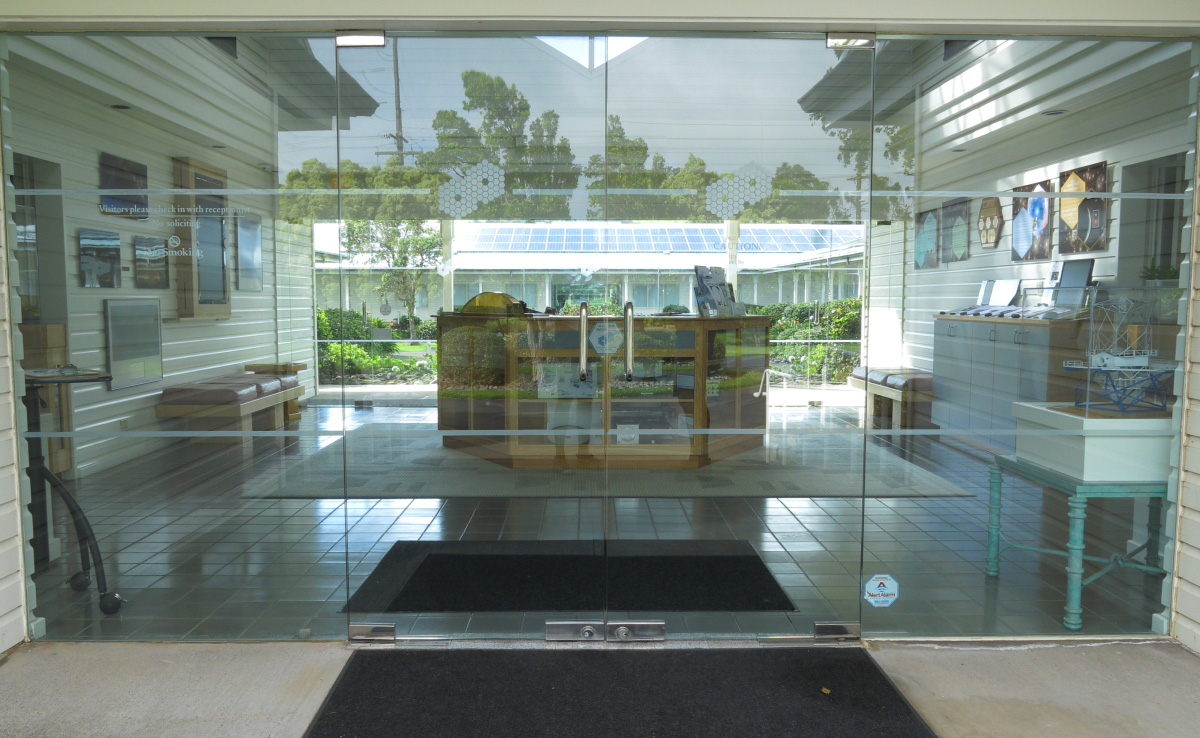 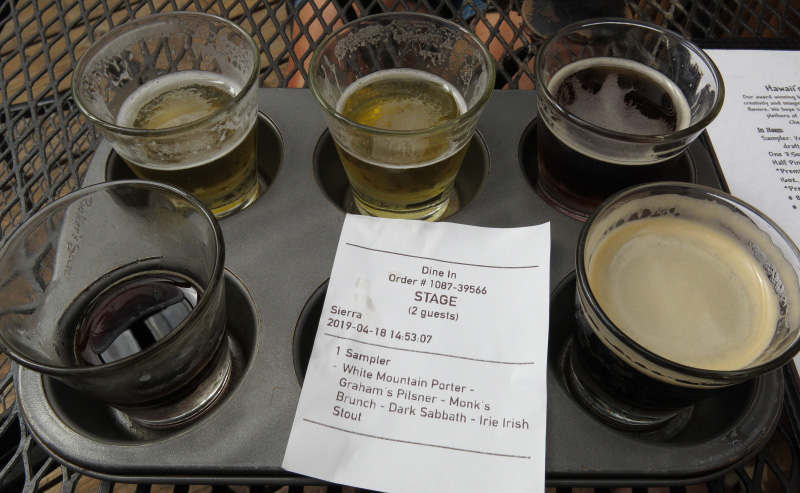 Earlier in the day we had stopped off for an
excellent lunch at a restaurant in Waimea. Earlier in the day we had stopped off for an
excellent lunch at a restaurant in Waimea.With no particular schedule, next we stopped at the Big Island Brewhaus, which I found to have some quite good beer. Their dark beers were impressive to me, and I am a bit of a snob when it comes to dark beer. It was nice to be back at an American craft brewery again, and like my local brewery here in Illinois, they had solar panels. We sat outside under a roof as a few rain showers passed by and the sun came out occasionally. Well, that is the end of the journey that I will write about here. Later that evening, after catching the sunset, we visited another fellow astronomer in Waikoloa Village, sipped a beer under the moonlit sky, and had a great time talking astronomy. I got a good night's sleep, and we had avocado on toast, with the avocados coming right off my friend's trees there on the property. The next day I caught a flight back to Maui, and visited with my friends some more. I did a bit of painting at my friend's house to thank them for allowing me to visit, and finished off a few other tasks. I was tired and ready to go home, but relaxed. After a nice dinner on Monday evening, I dropped of the rental car again and caught the first of my flights back to Illinois, knowing I had a lot of photo processing and writing to do. Now, that is mostly done, with the exception of some non-HDR images that I haven't gotten to yet. It was an amazing trip, complete with some astronomical experiences that I didn't think I would have. I have to end the article by thanking all of those that hosted me, the trip would not have been what it was without them. Thank you Allan, Peter, Stephen, Stan, Ellen, Hirofumi, and Dom, I hope to see you all again soon. |
Clear, dark, southern skies, hang loose, 8-meter telescopes are really, REALLY big, and it is good to be home! Hope to be back in Oz in a few years. -Mike Lockwood, Lockwood Custom Optics |